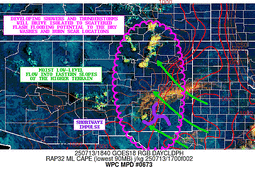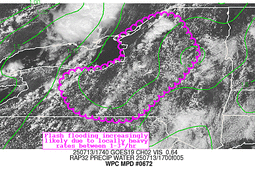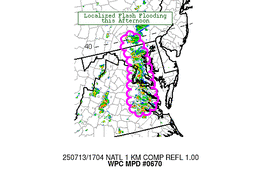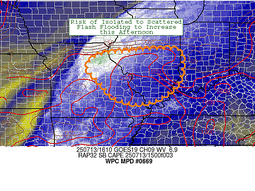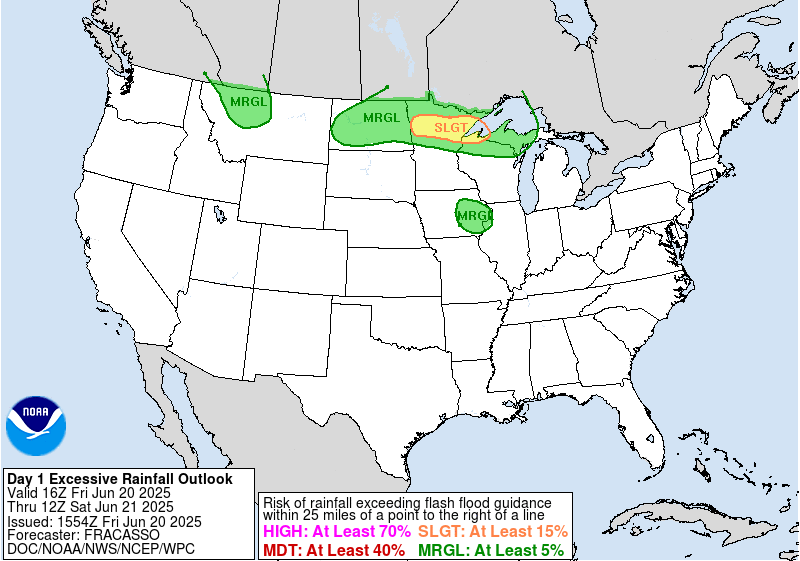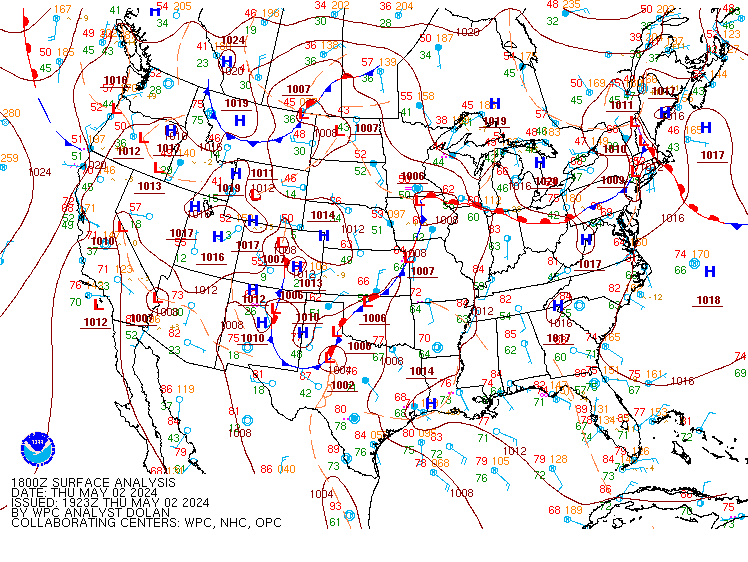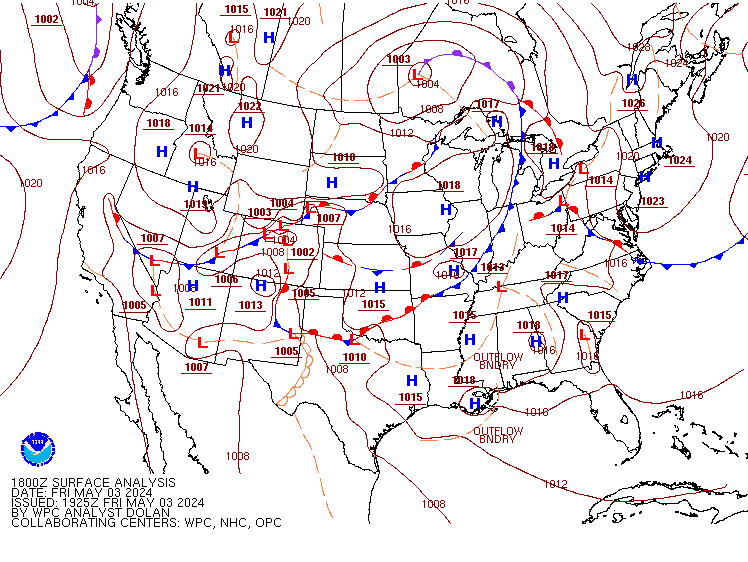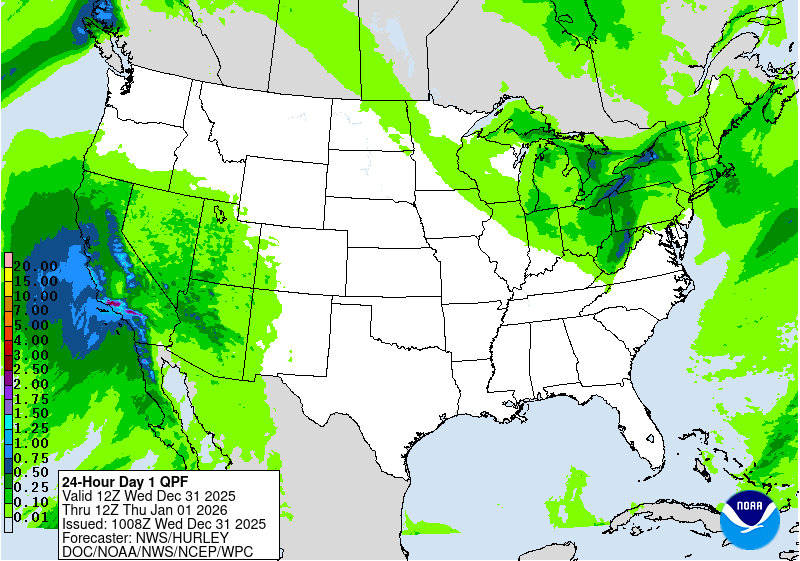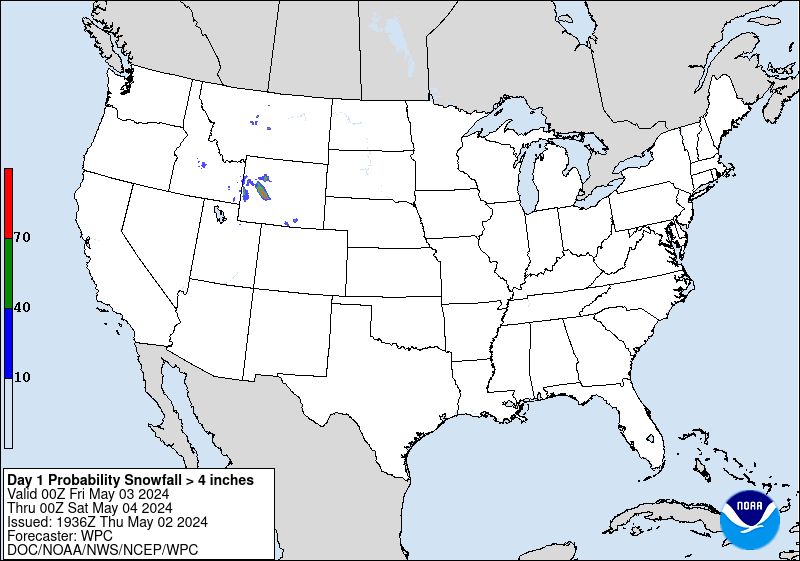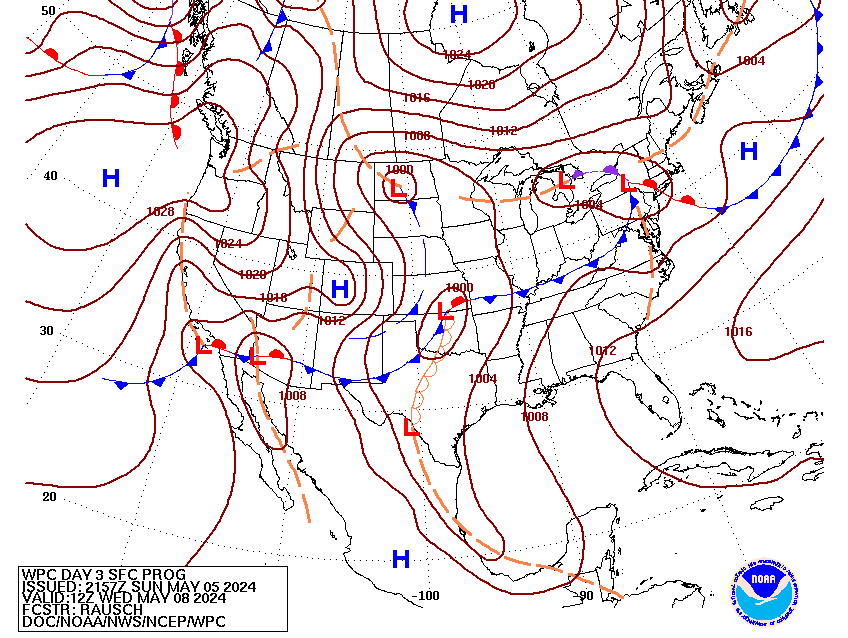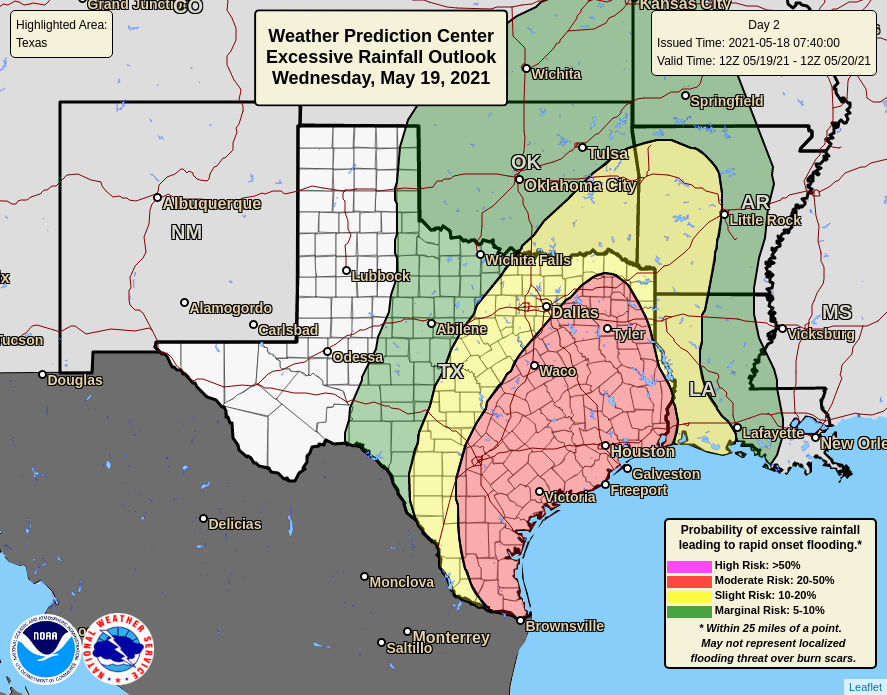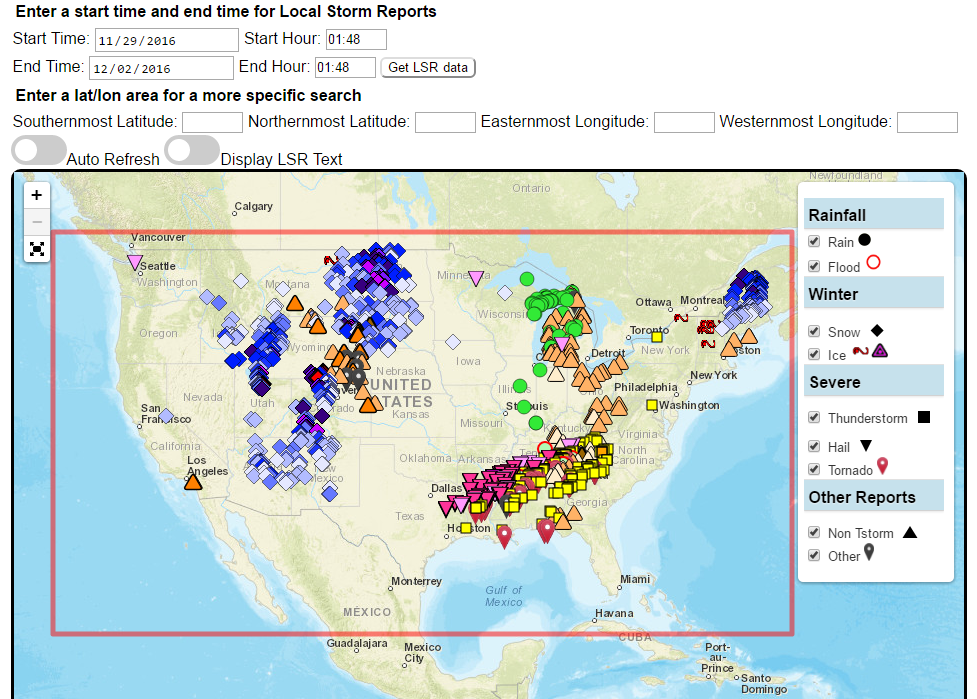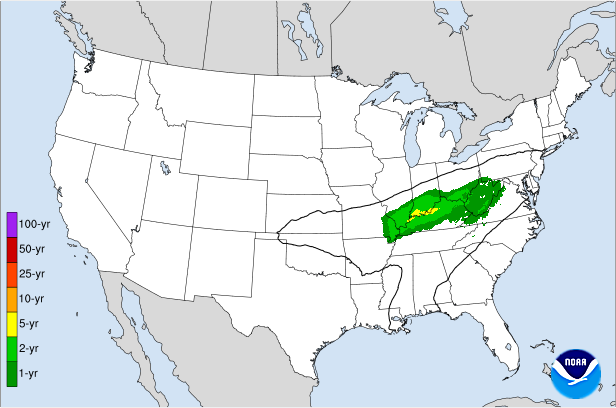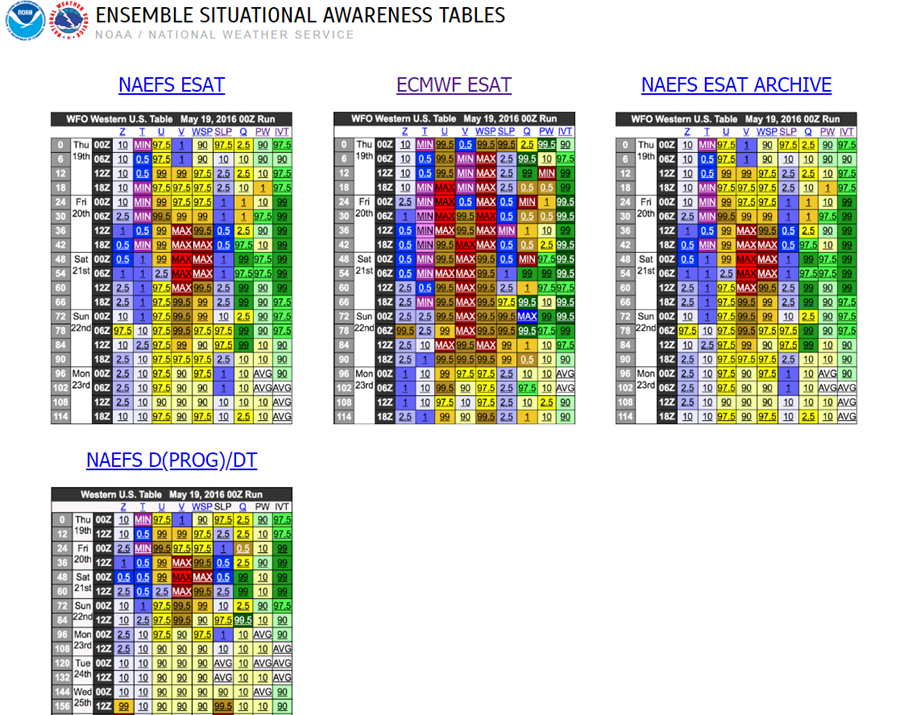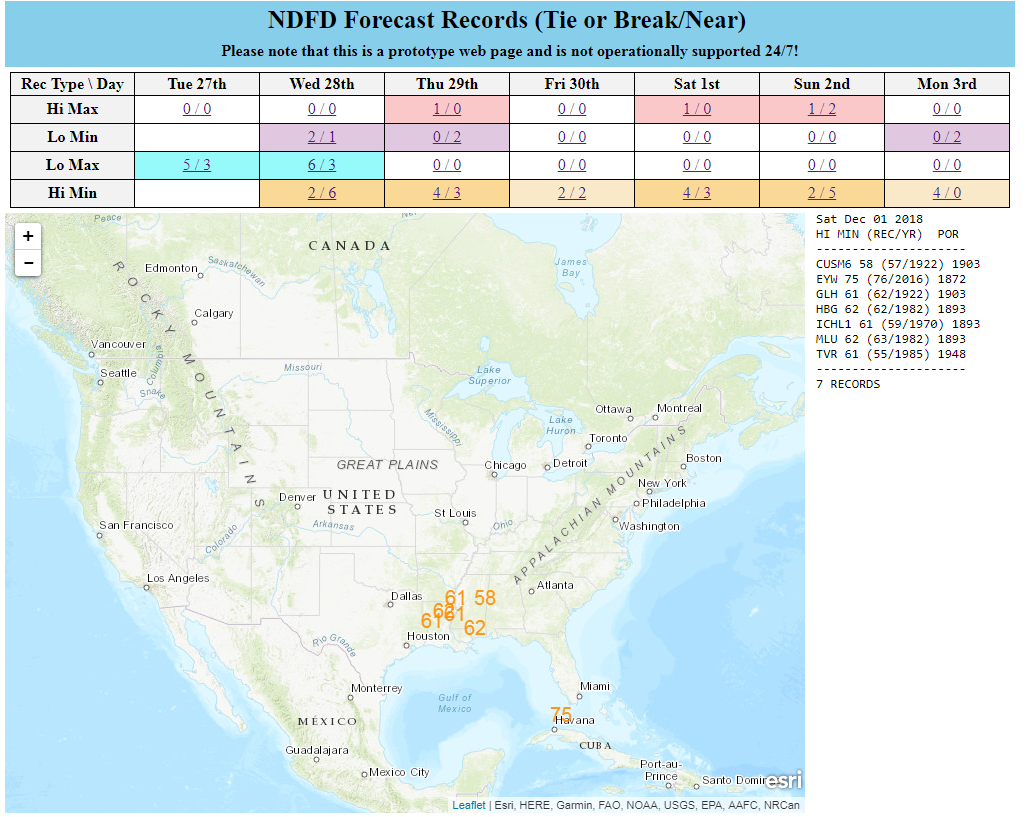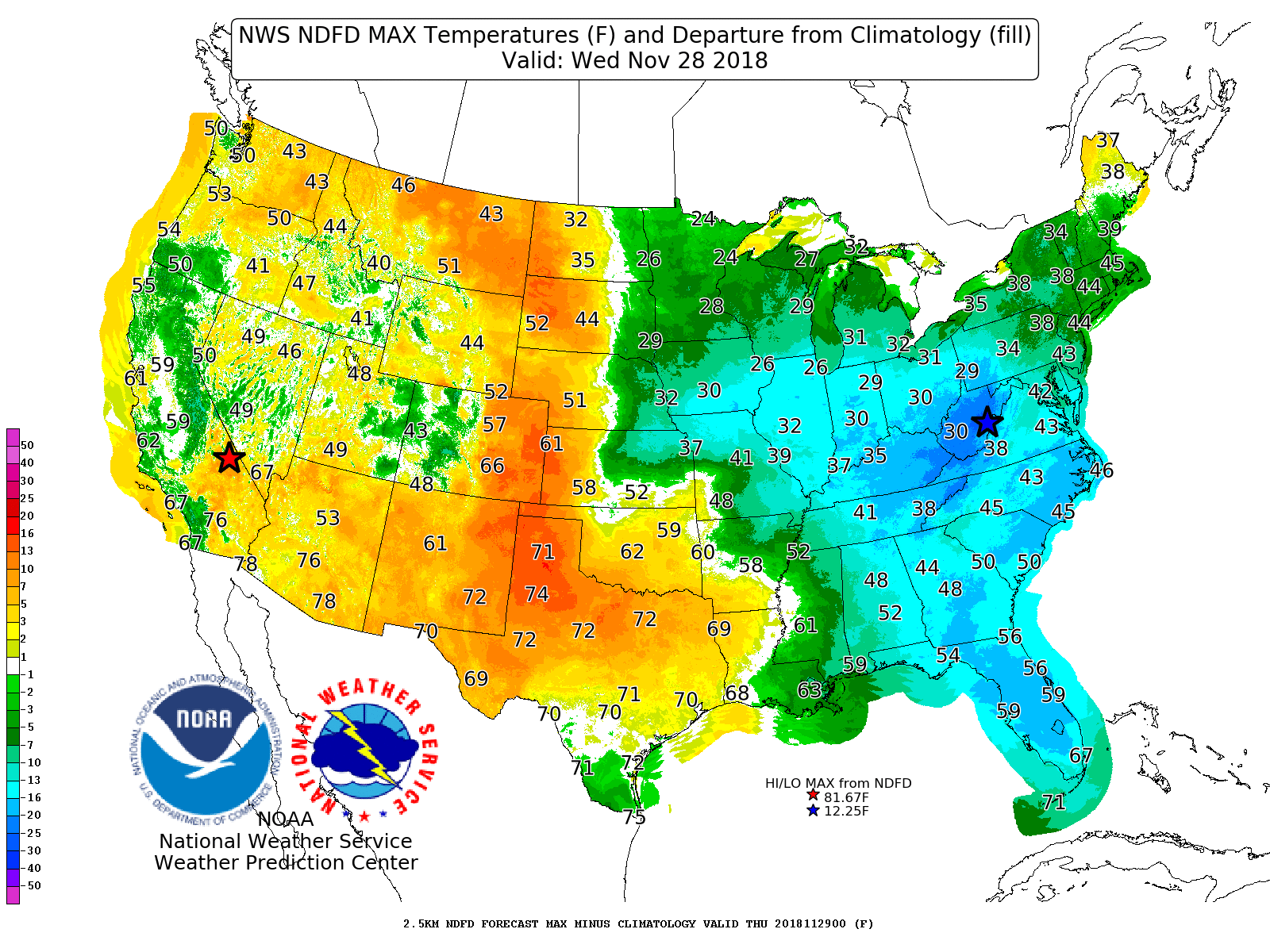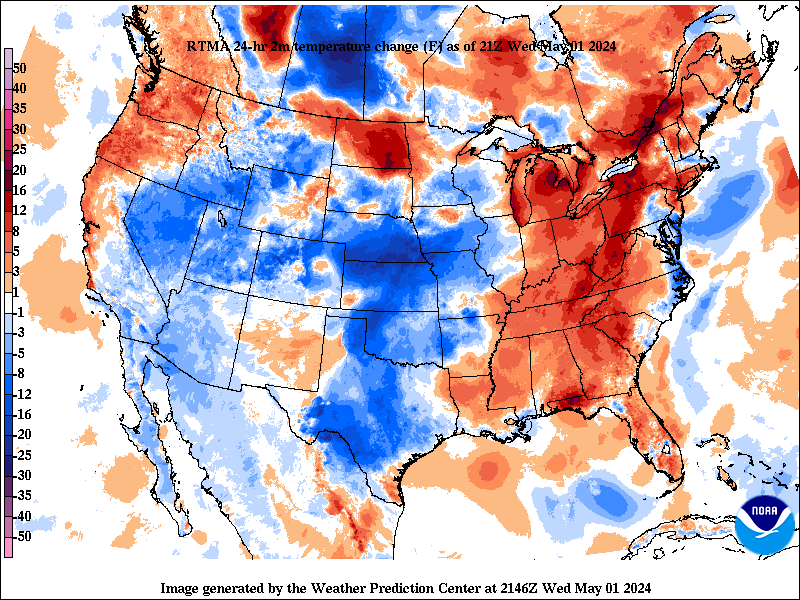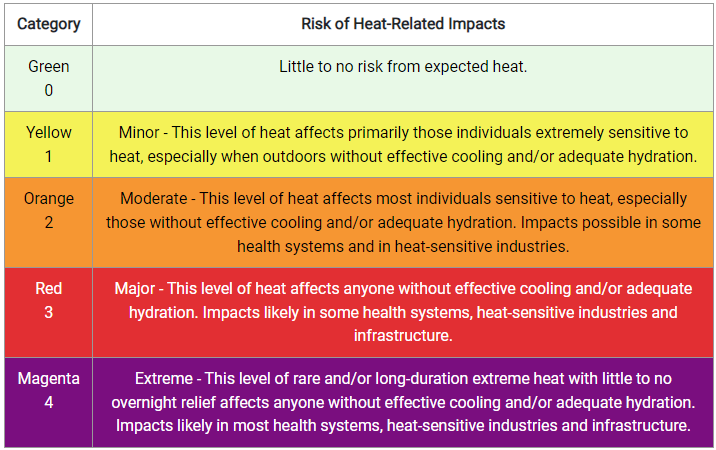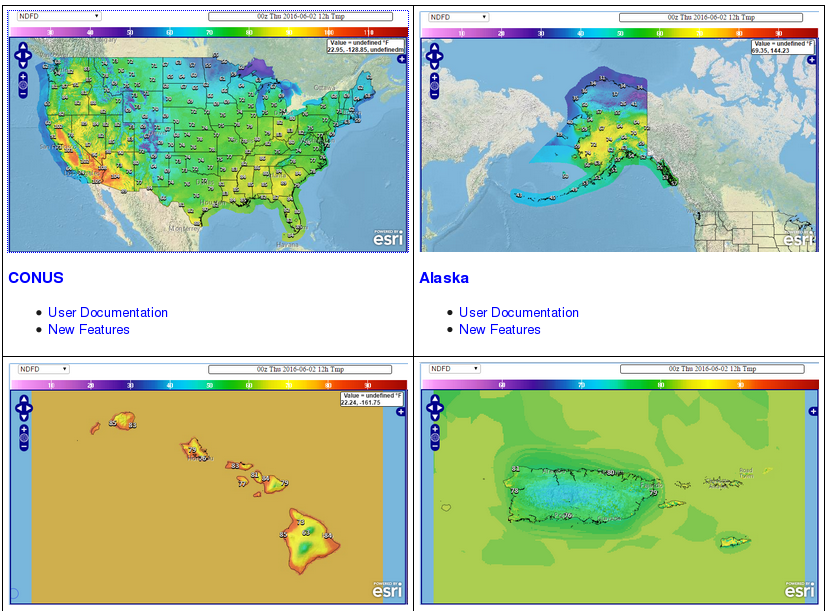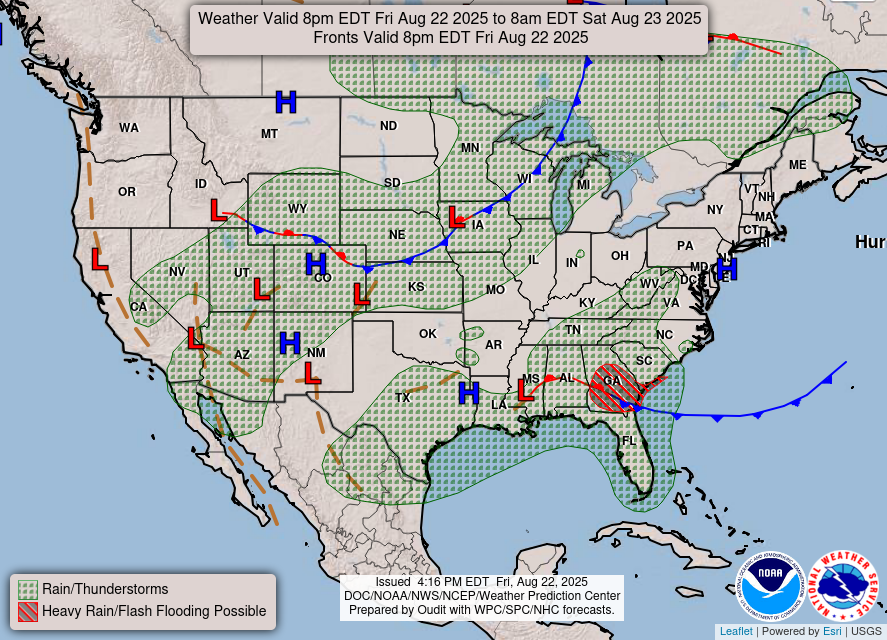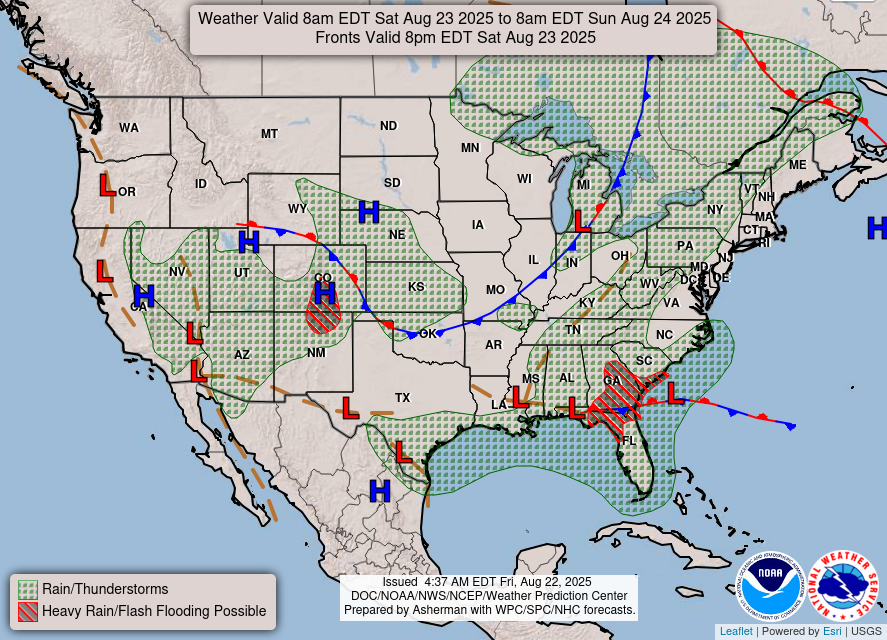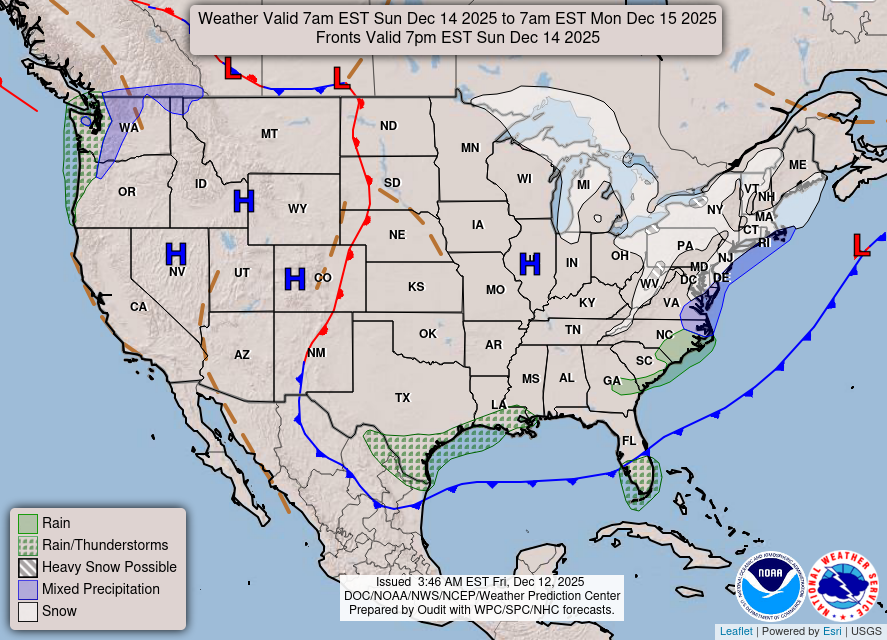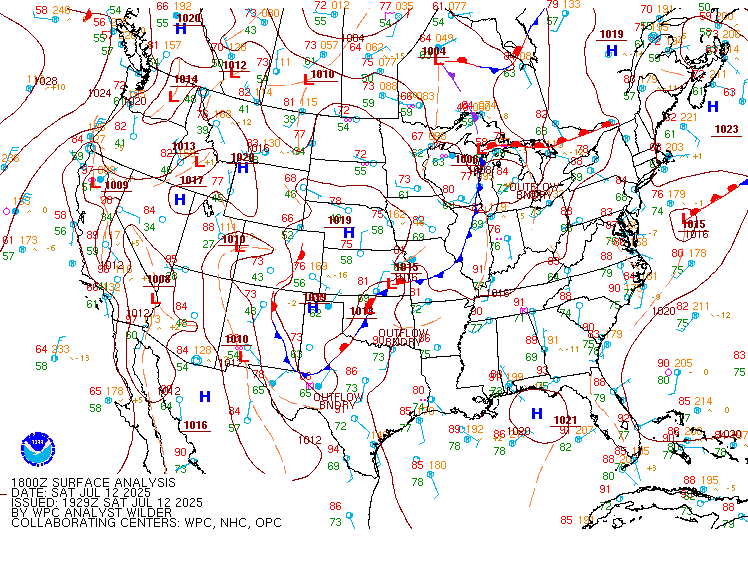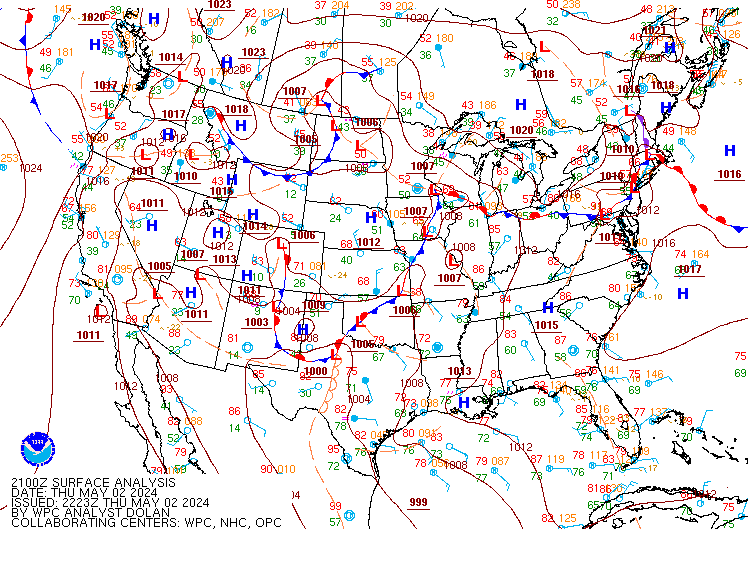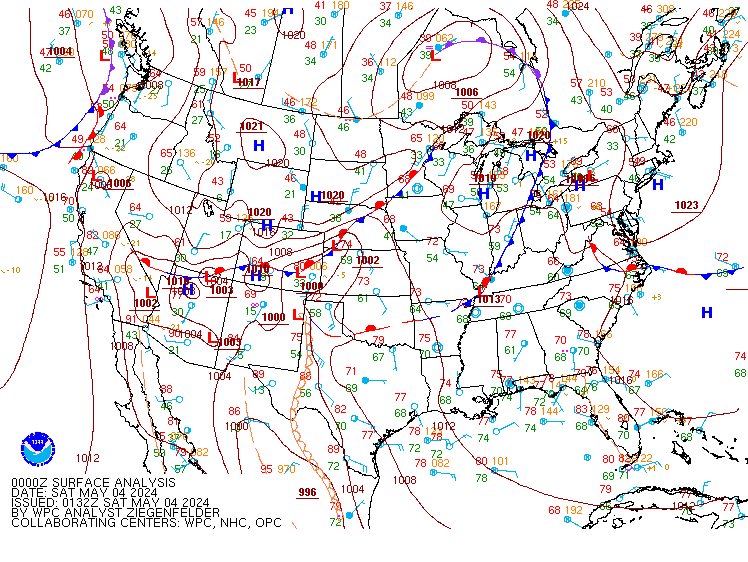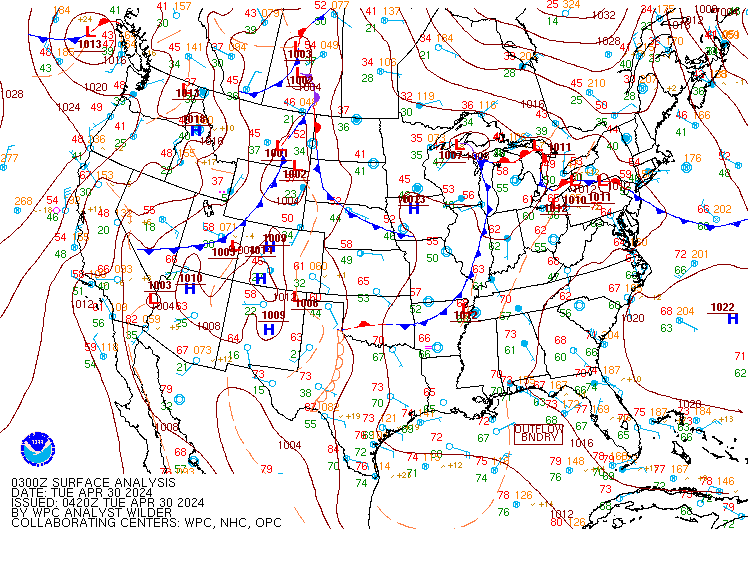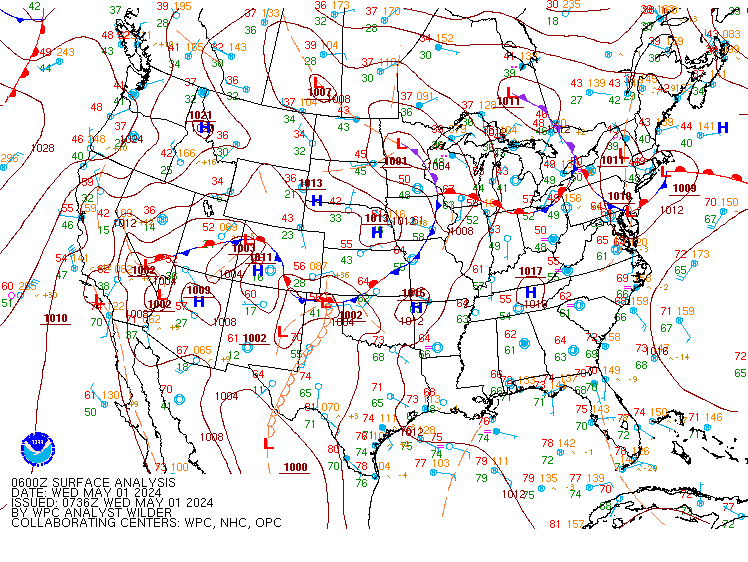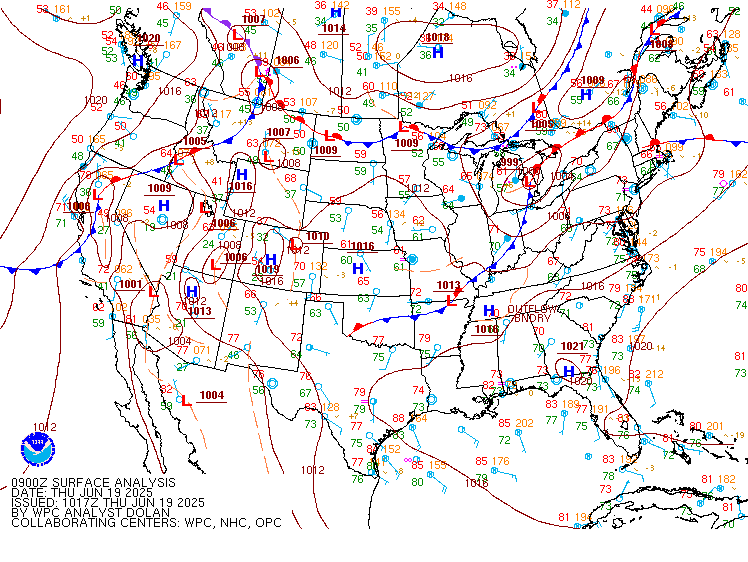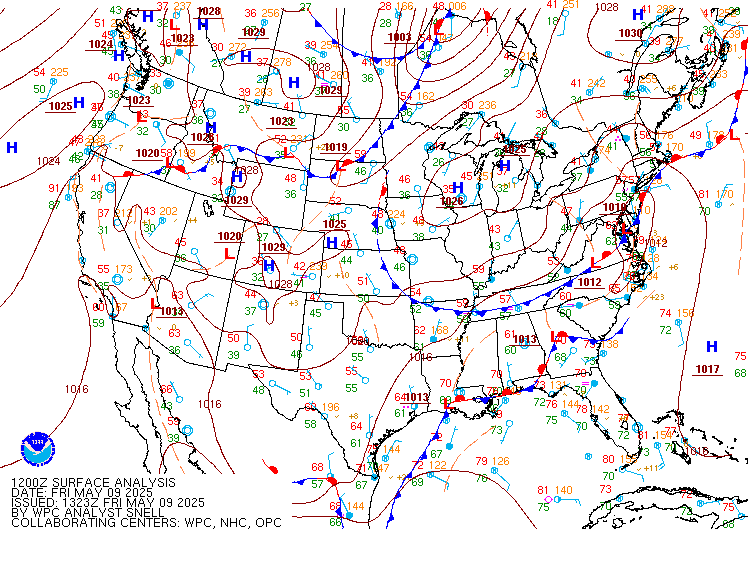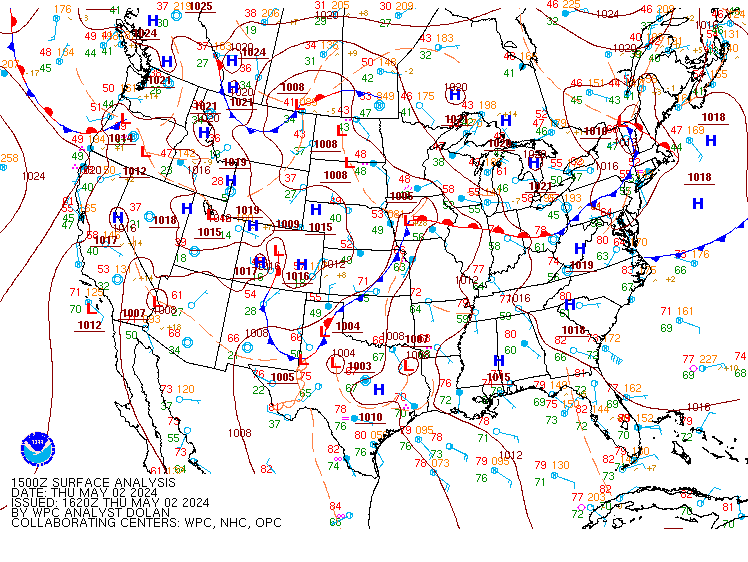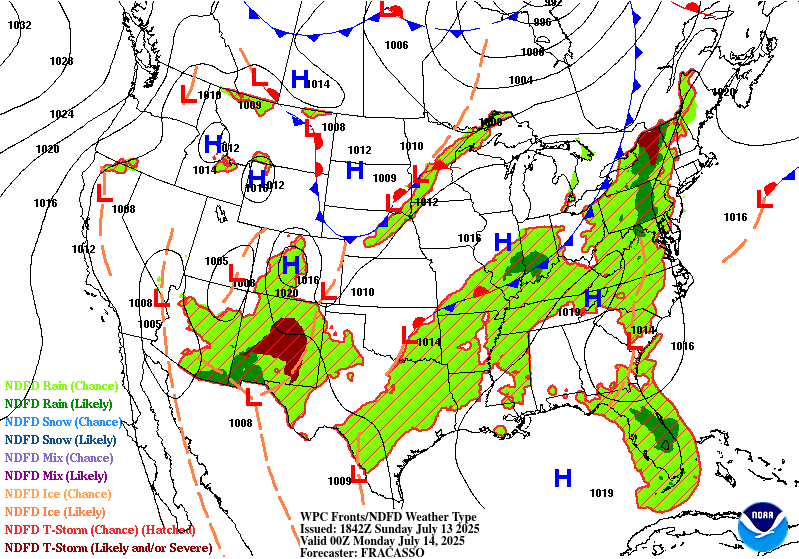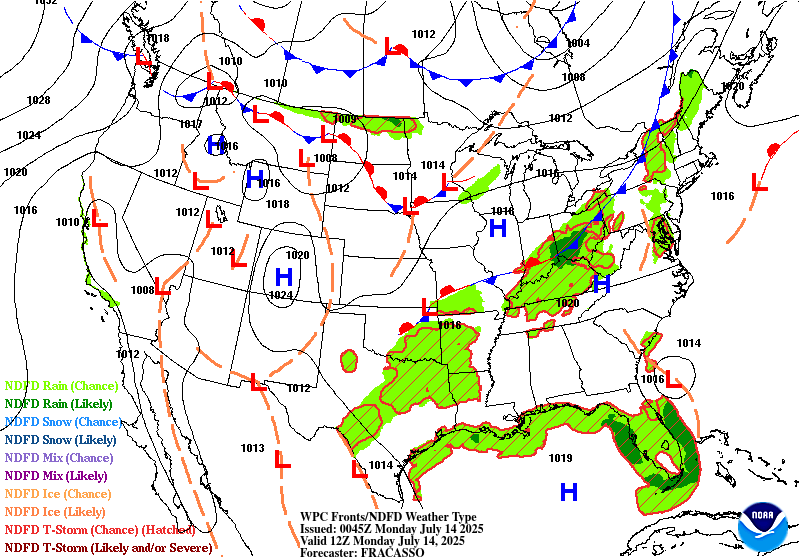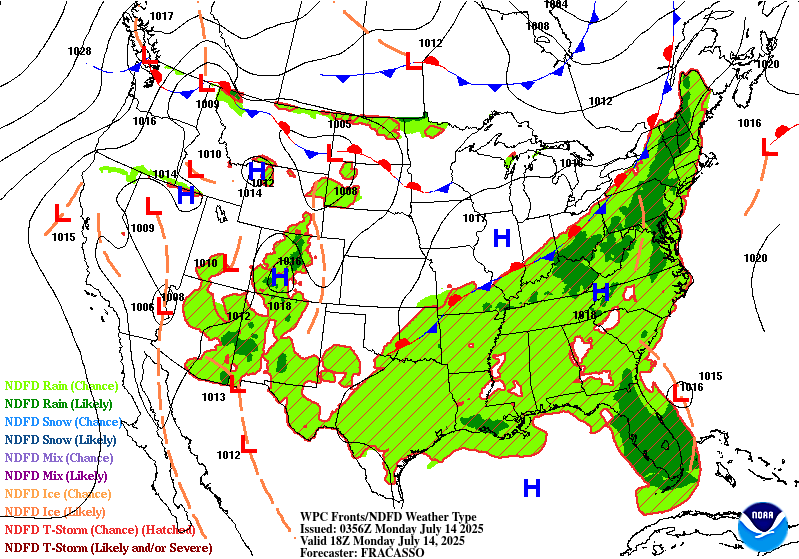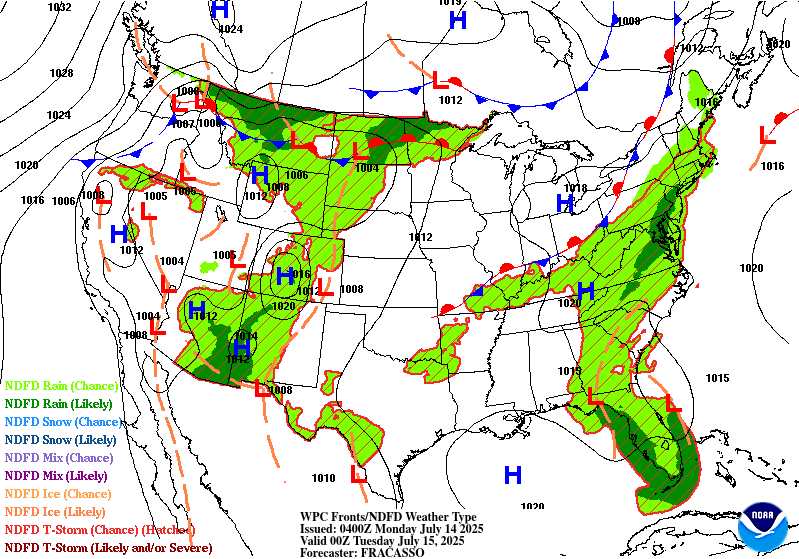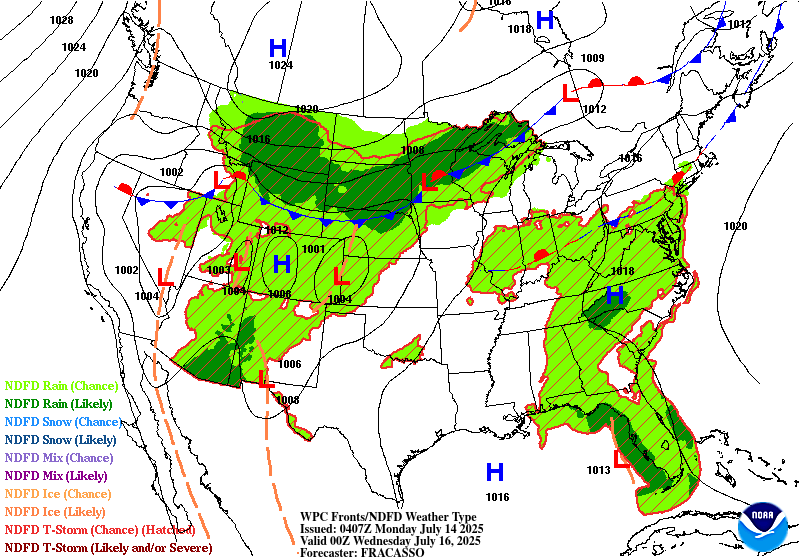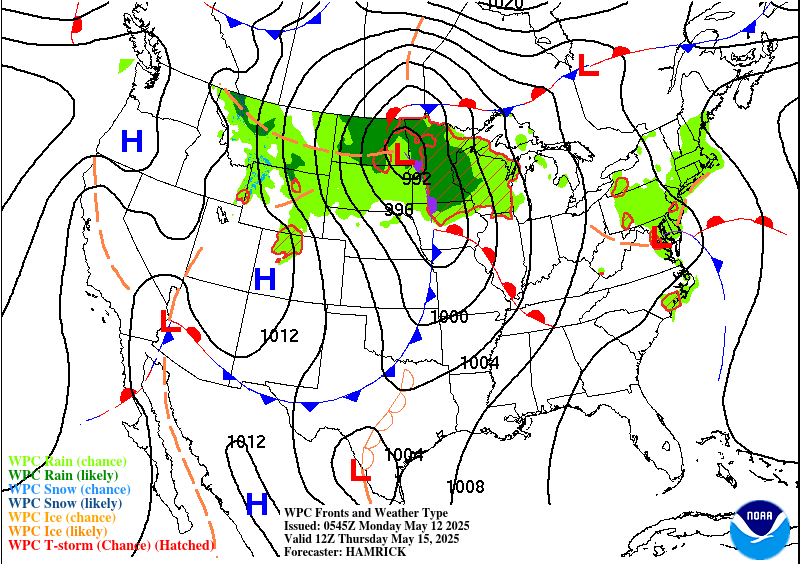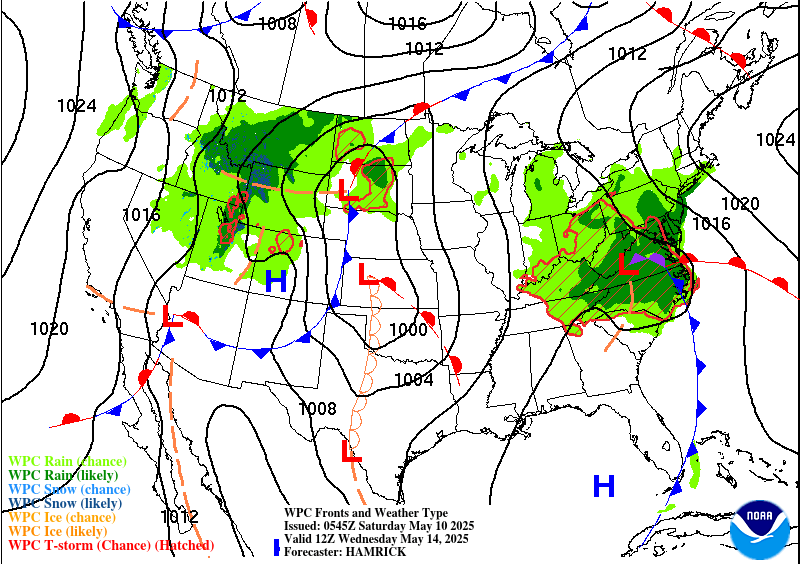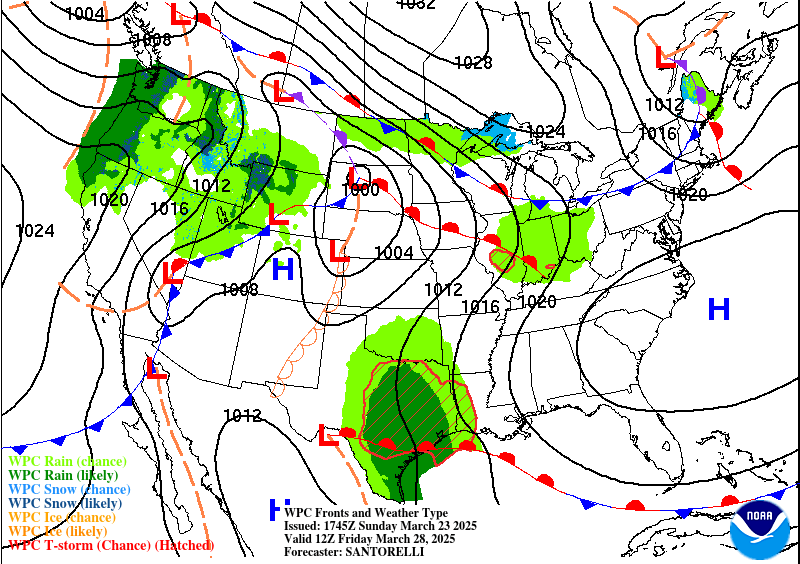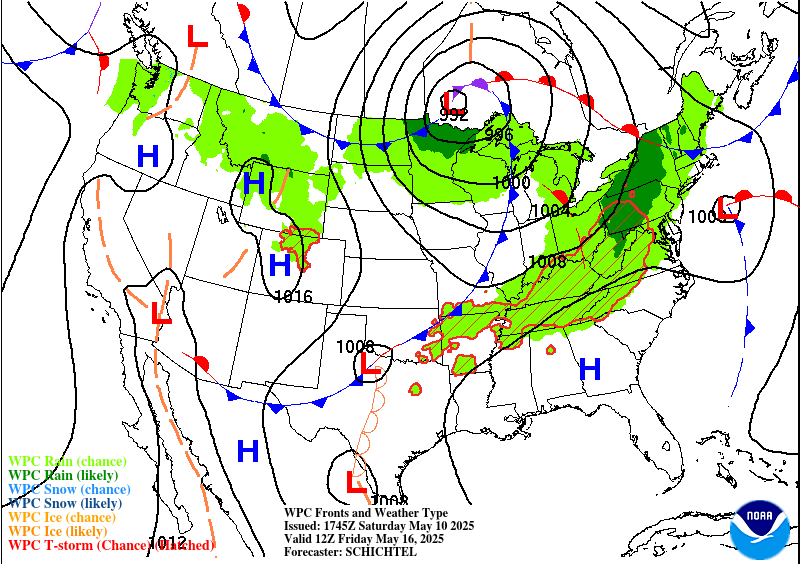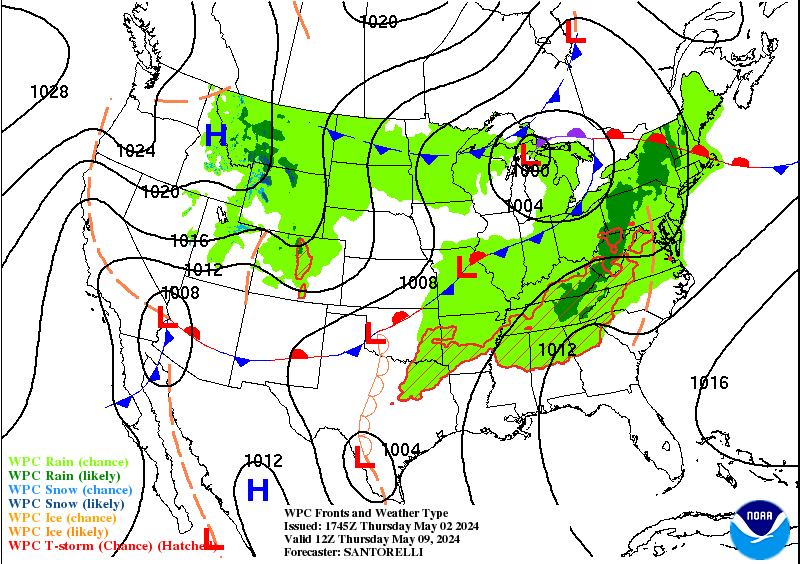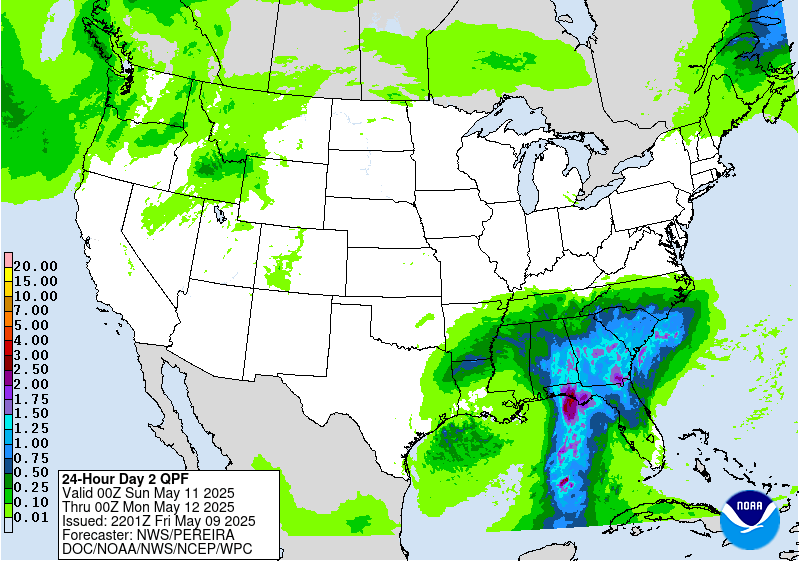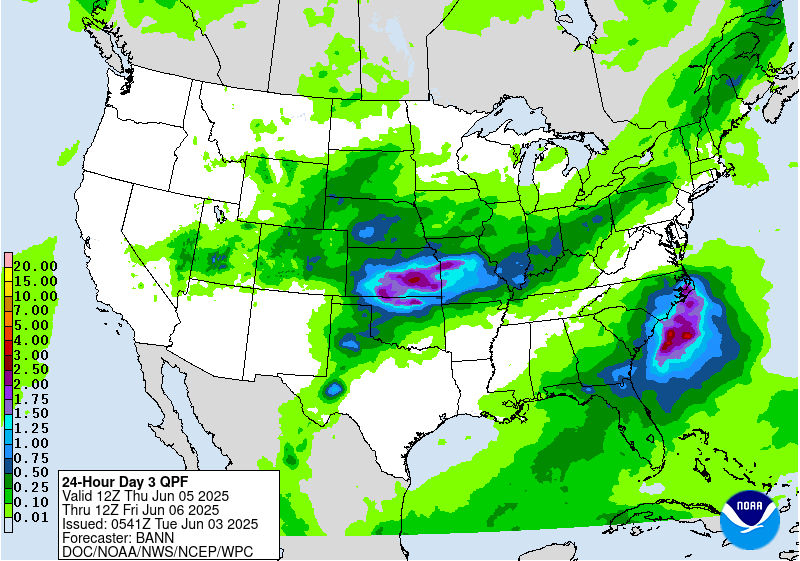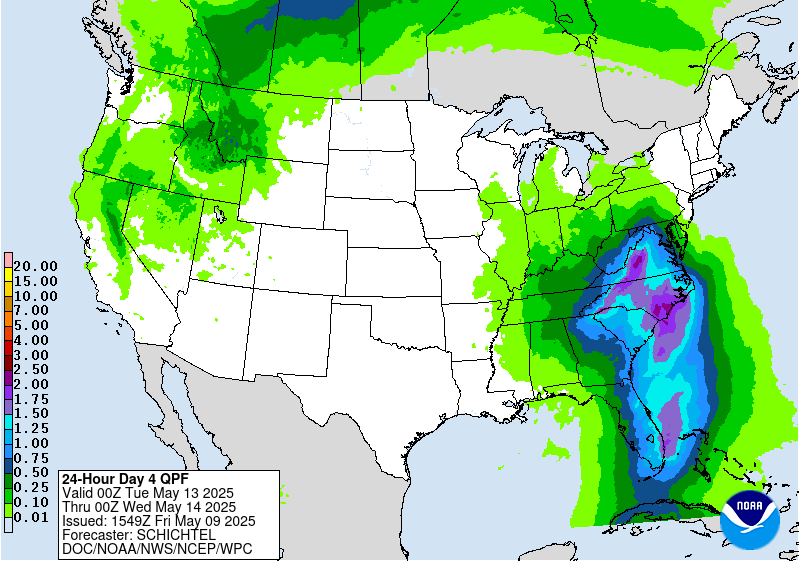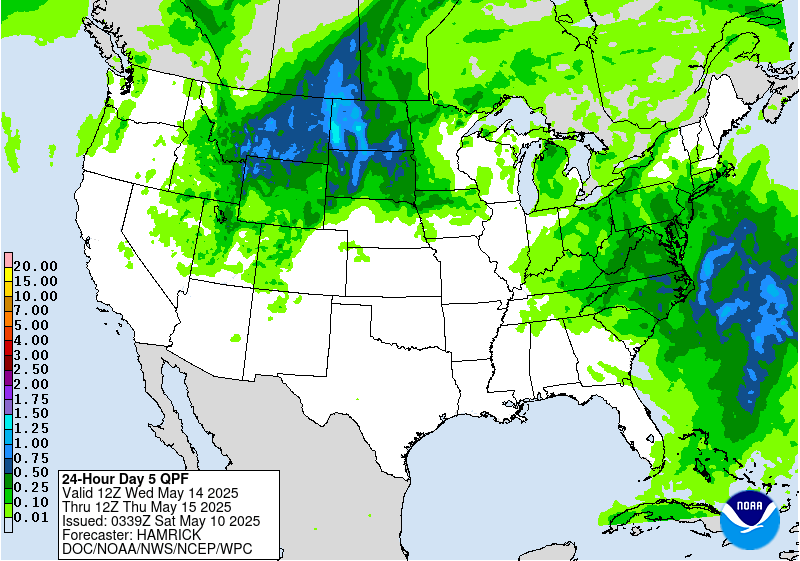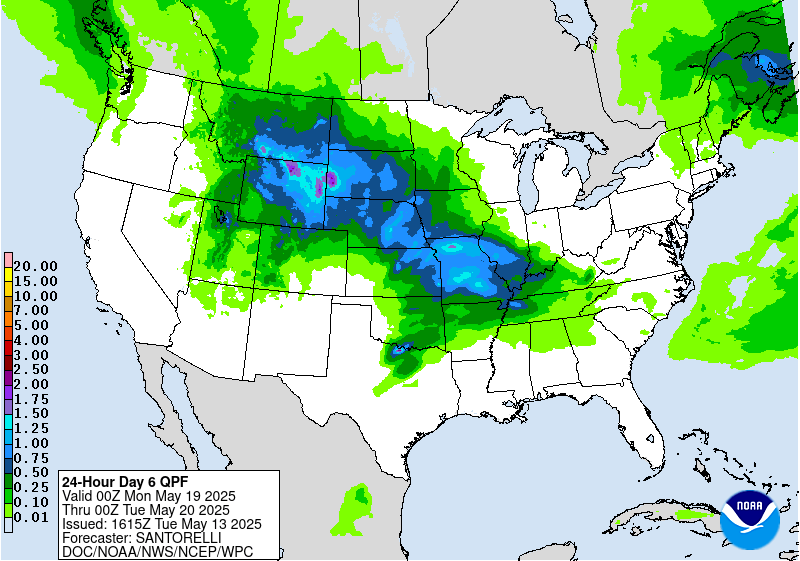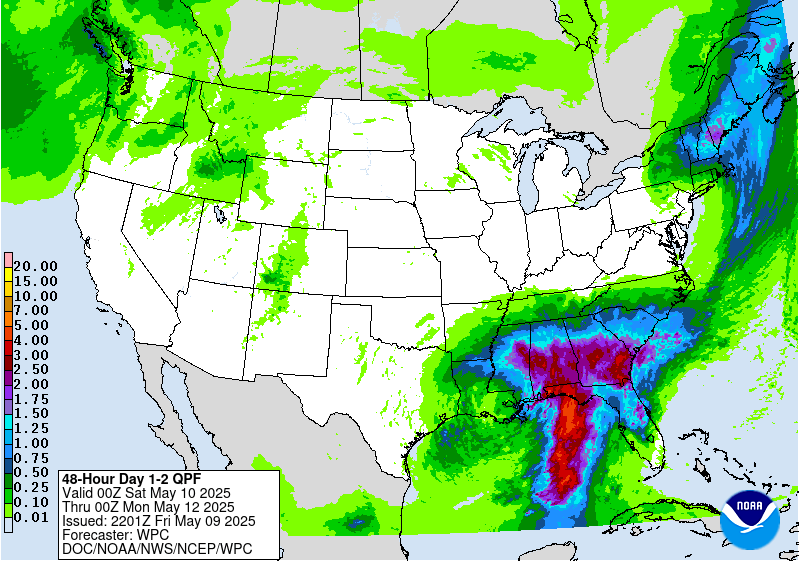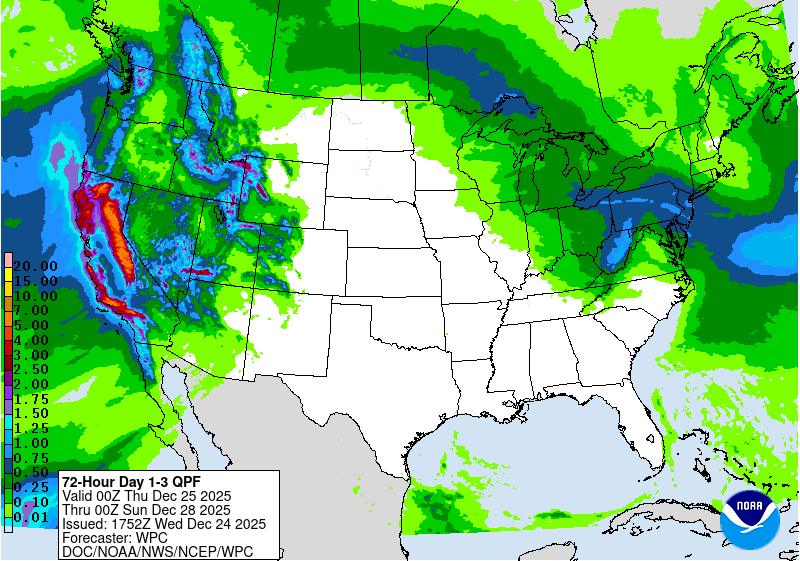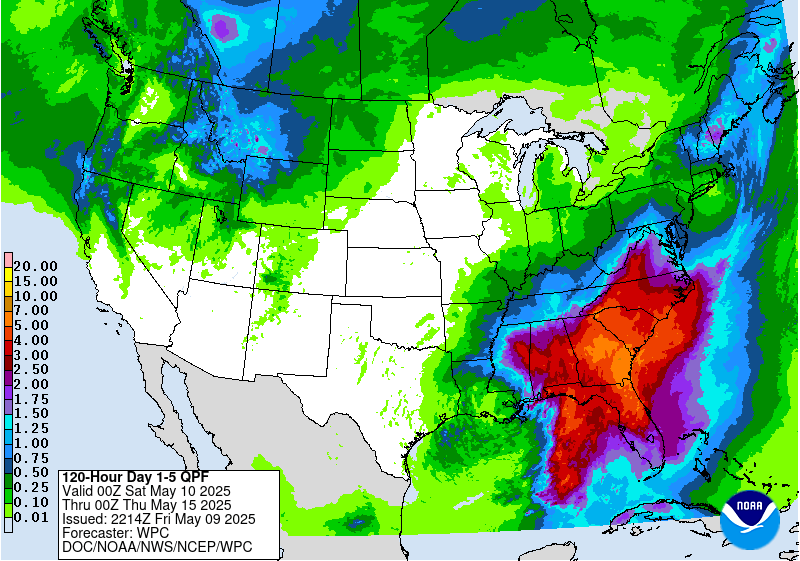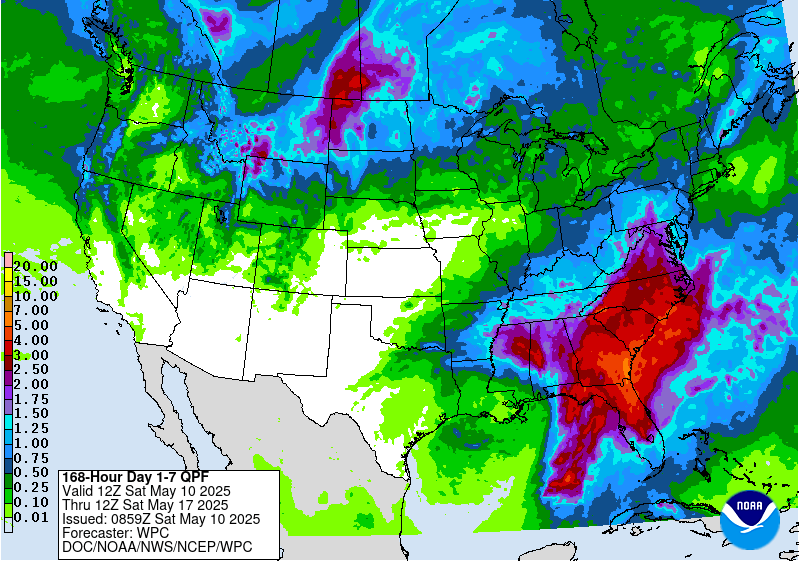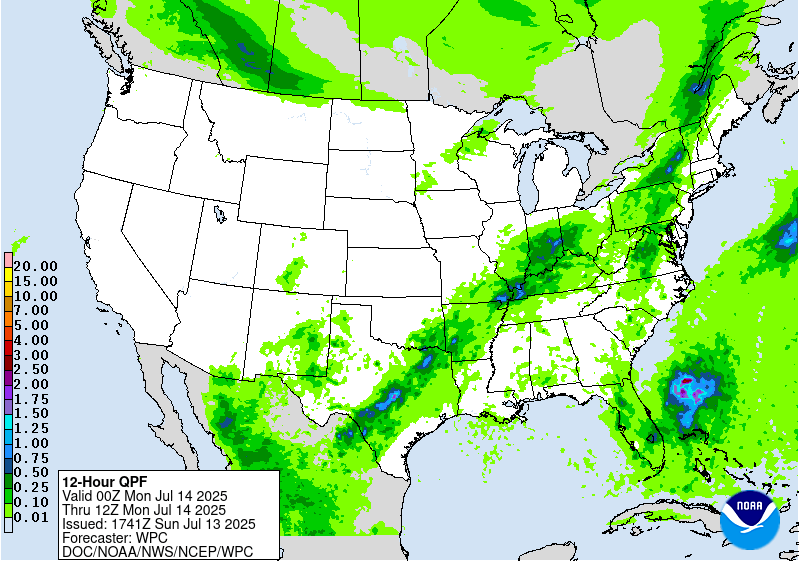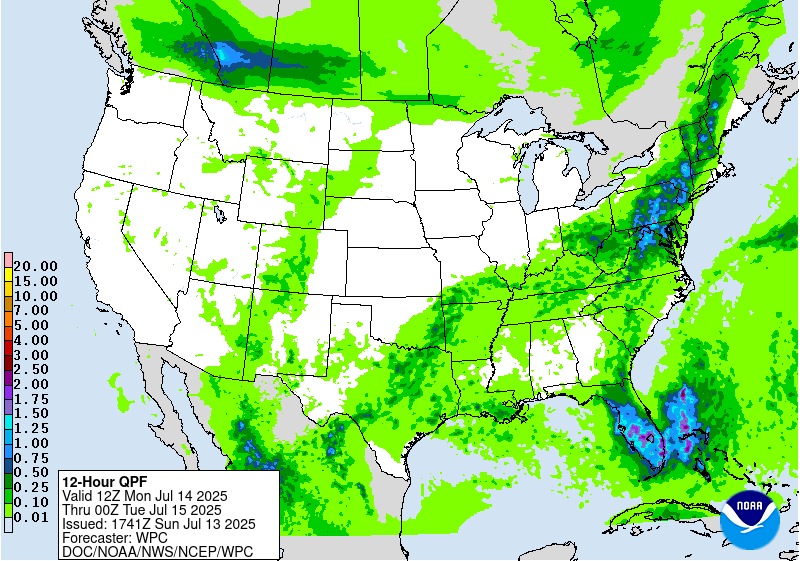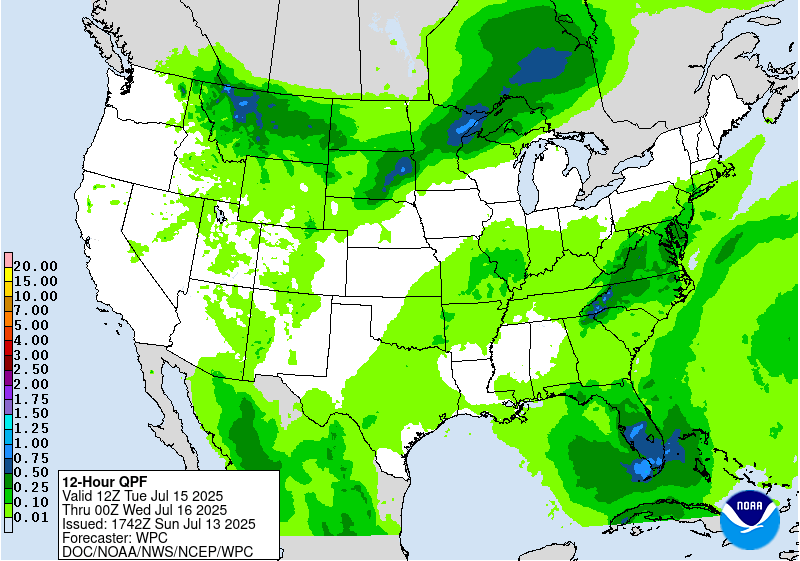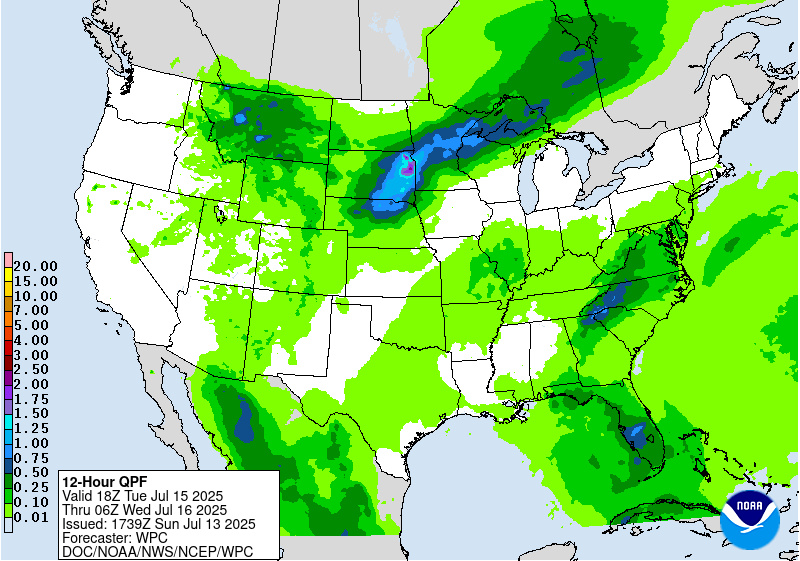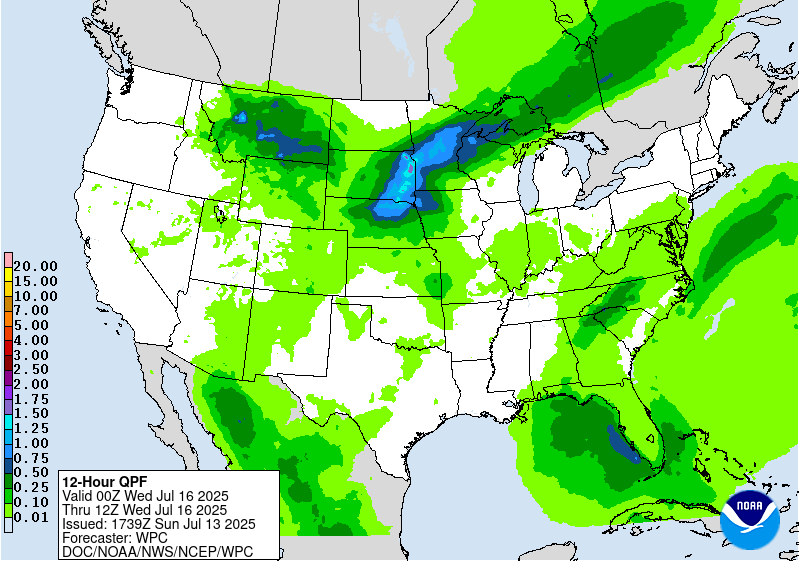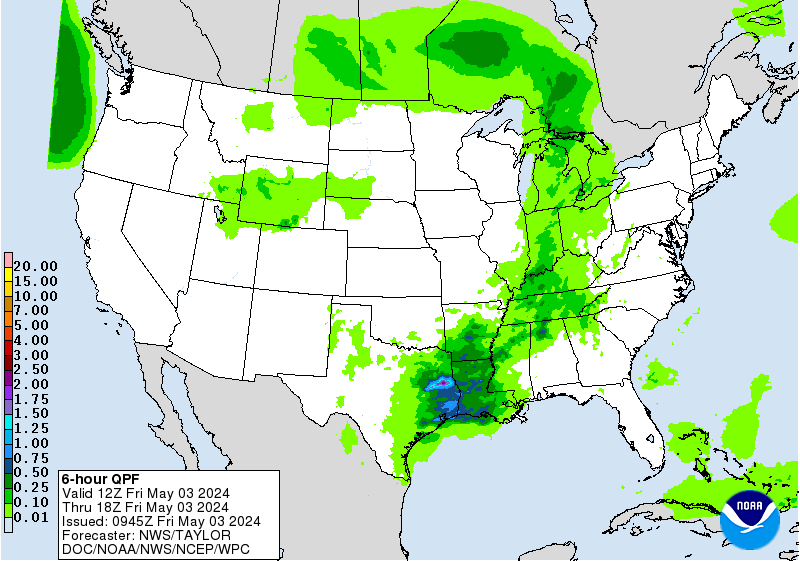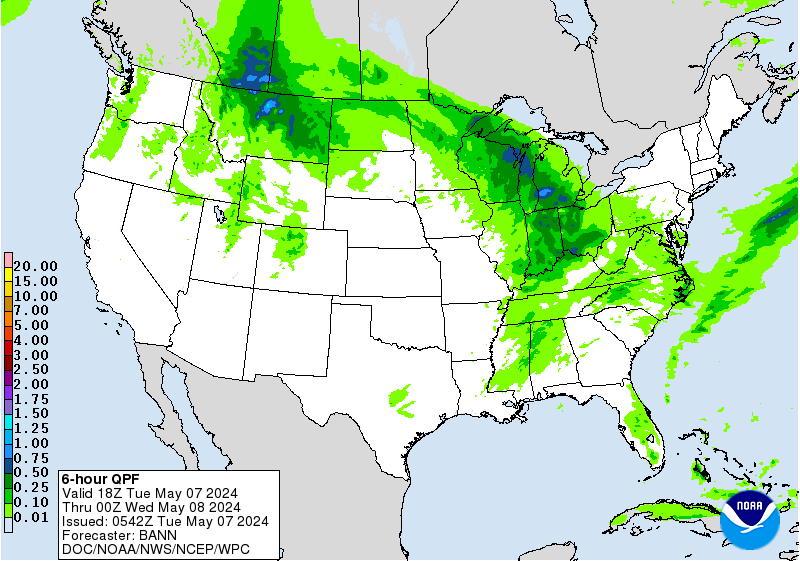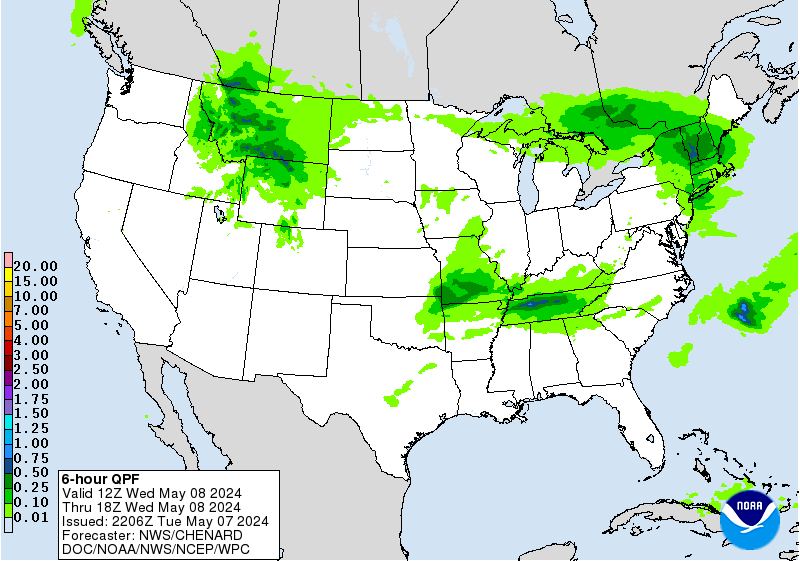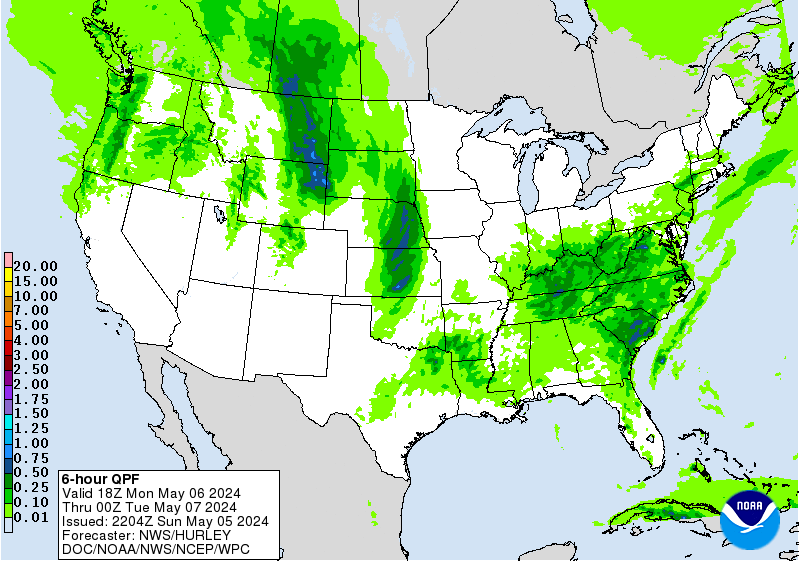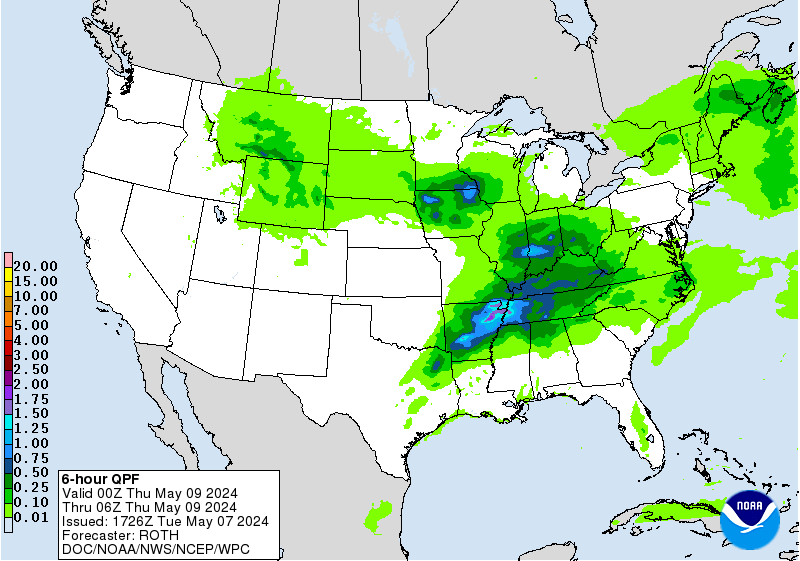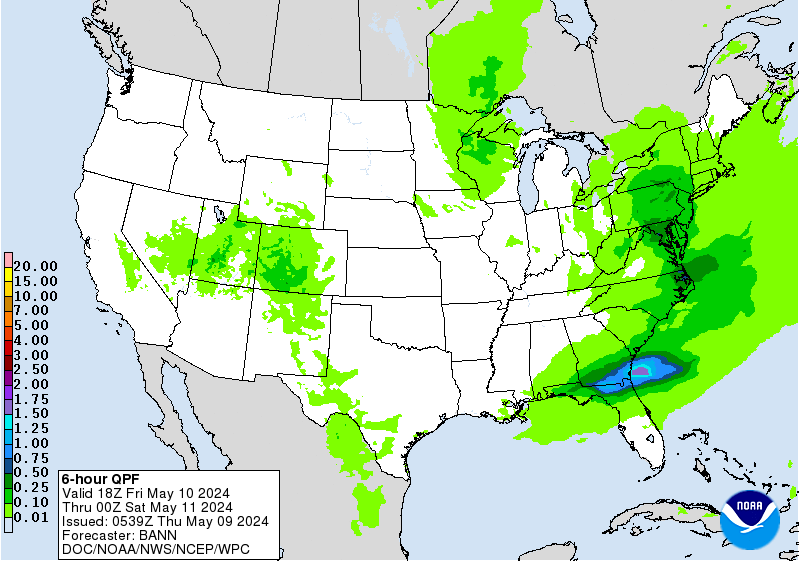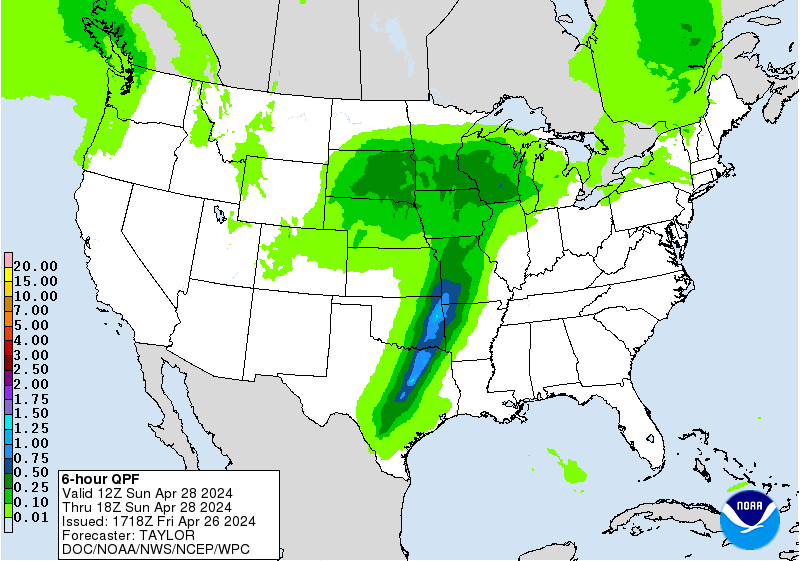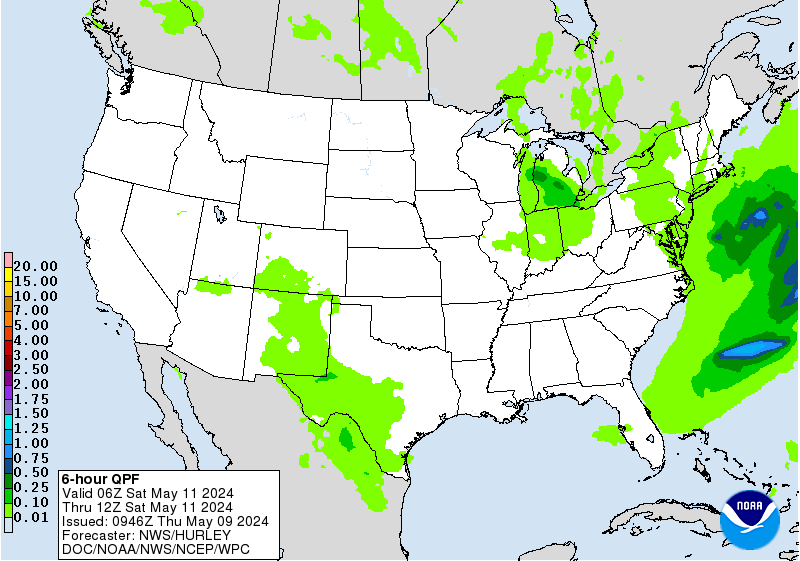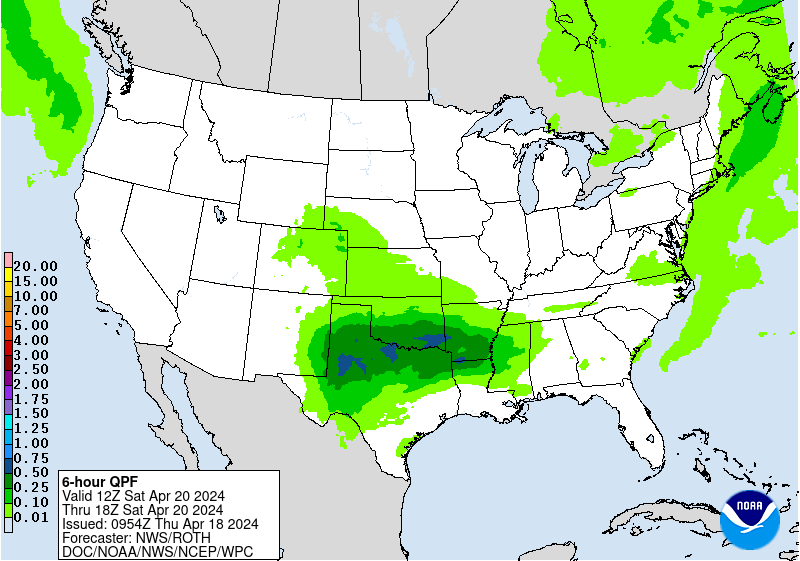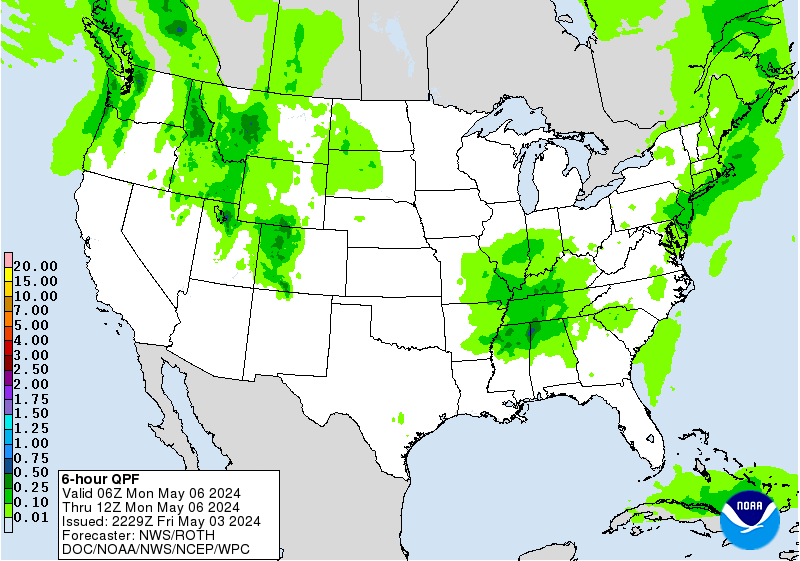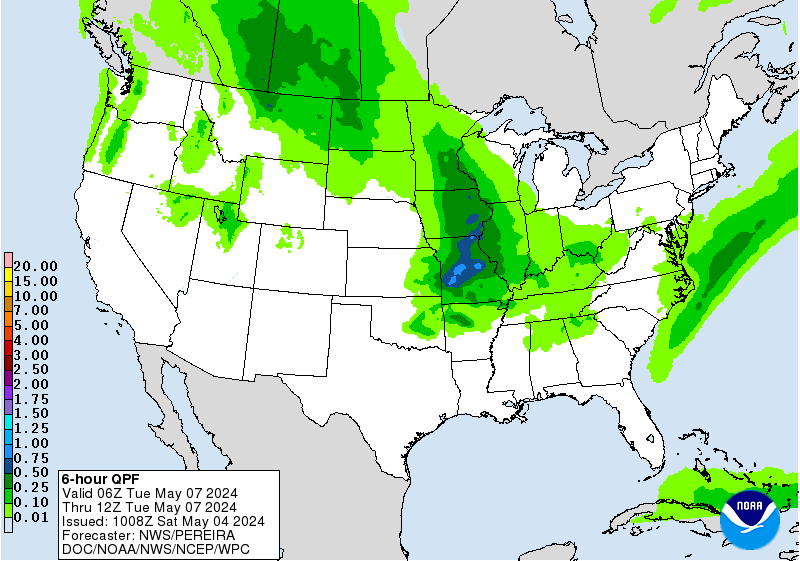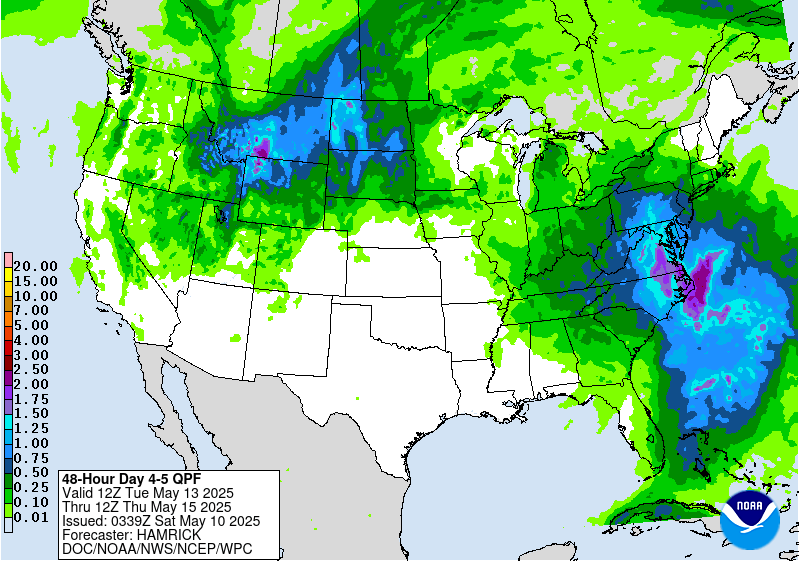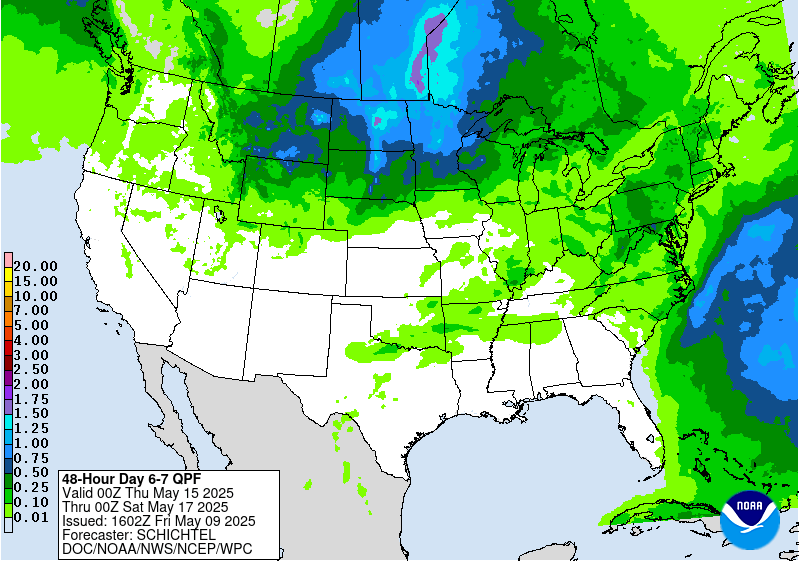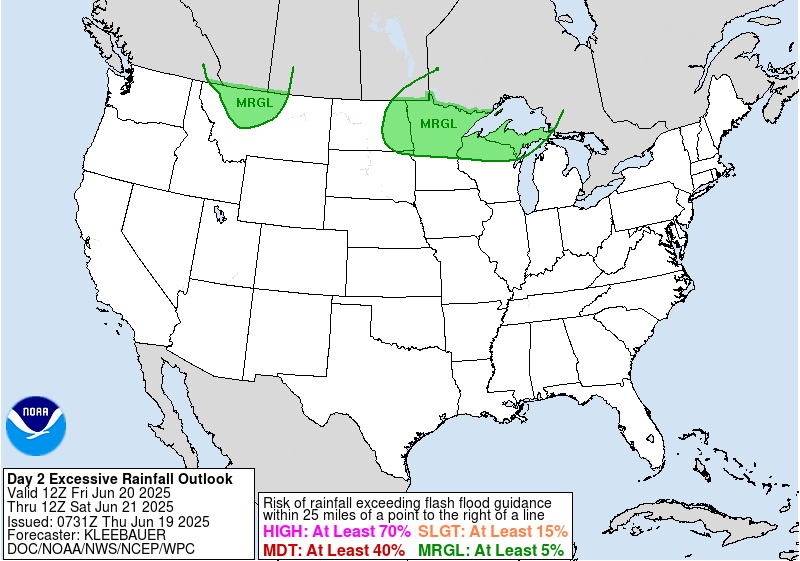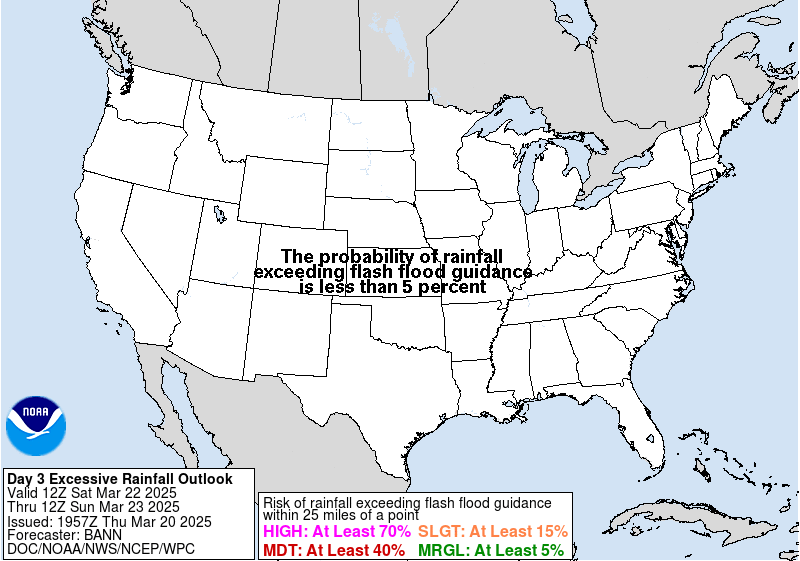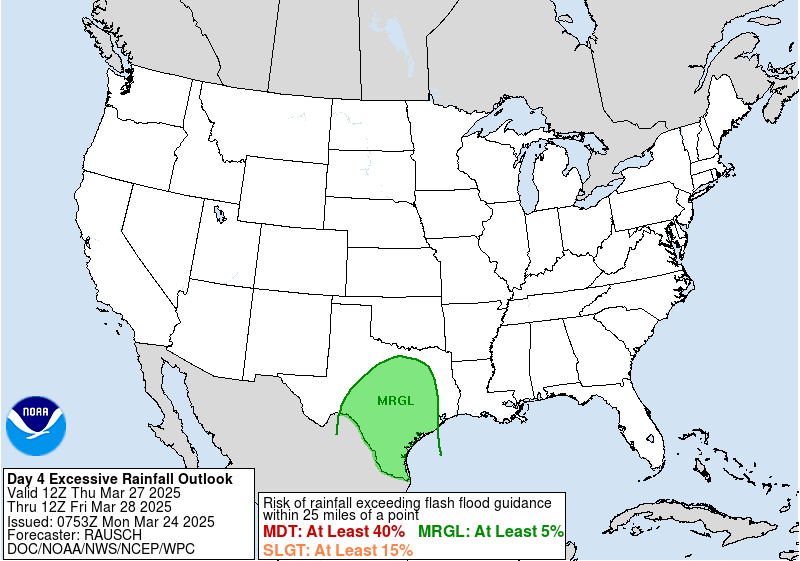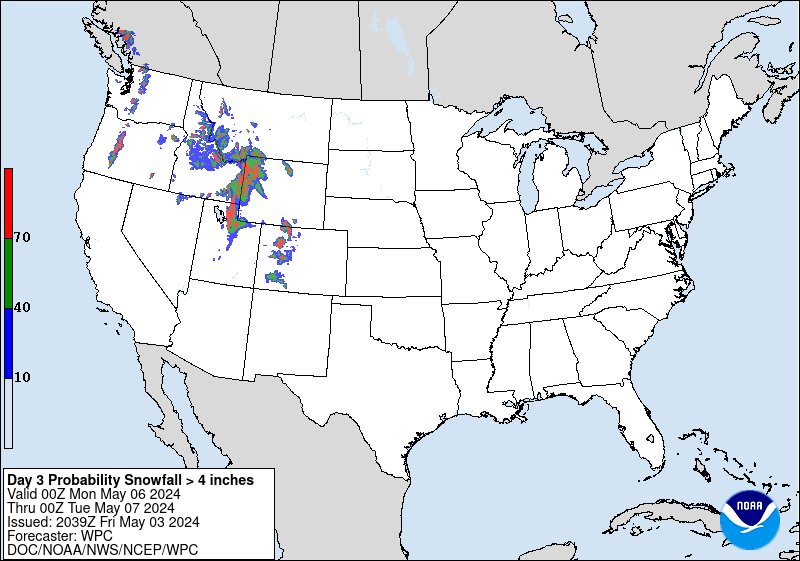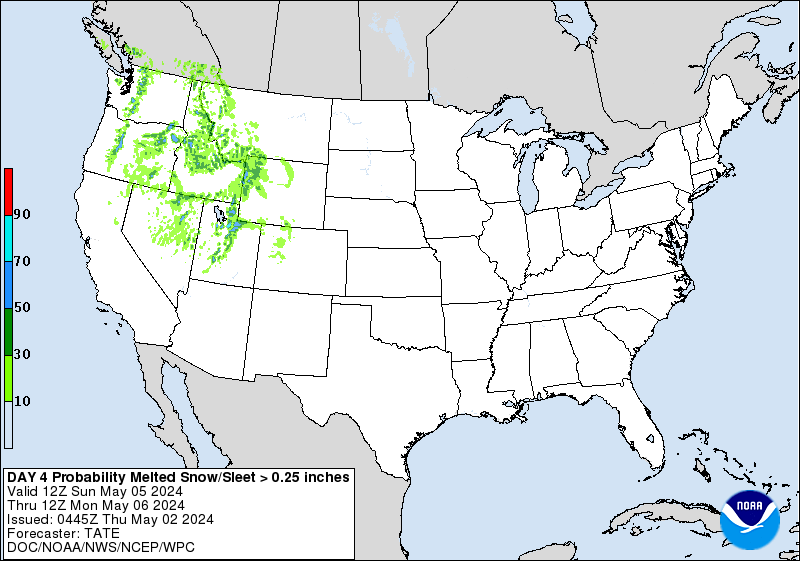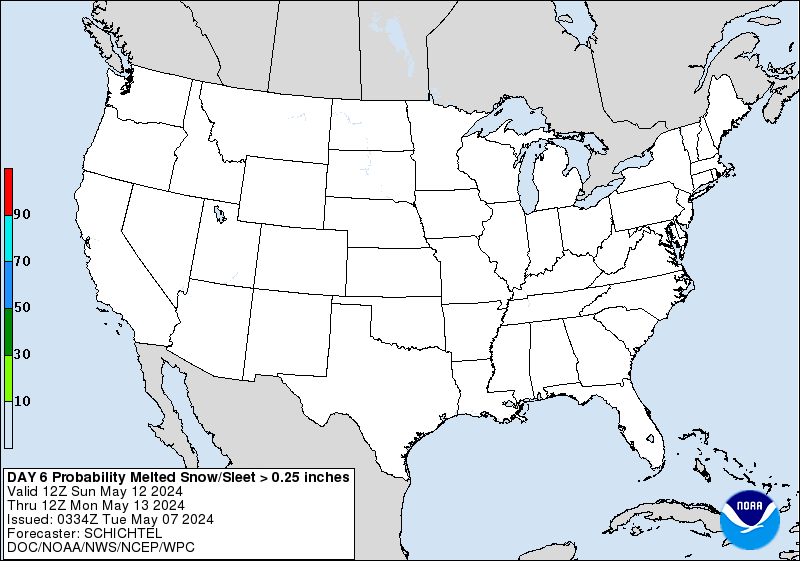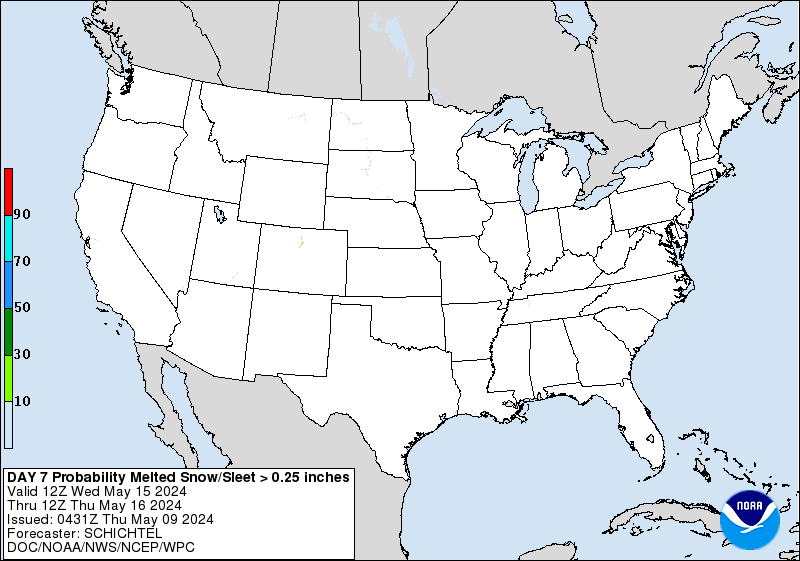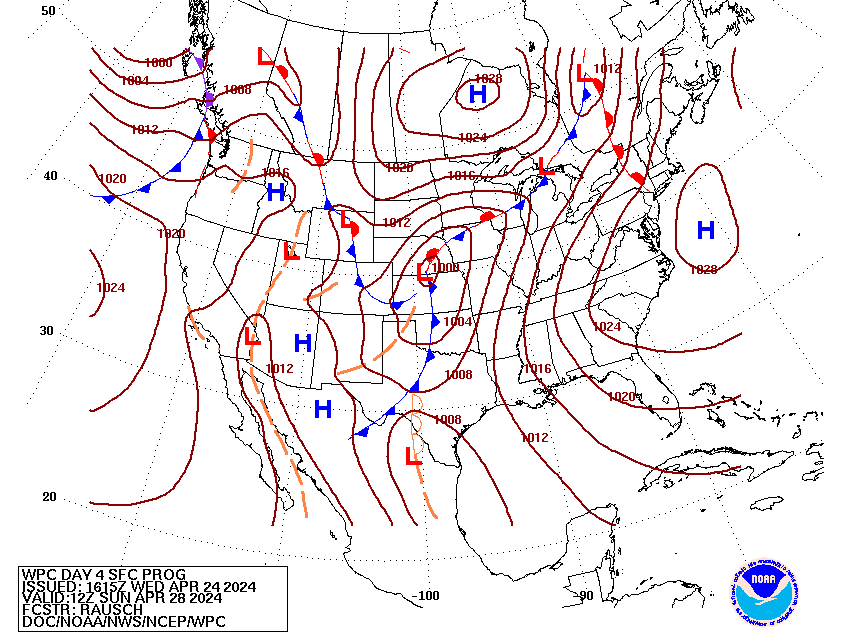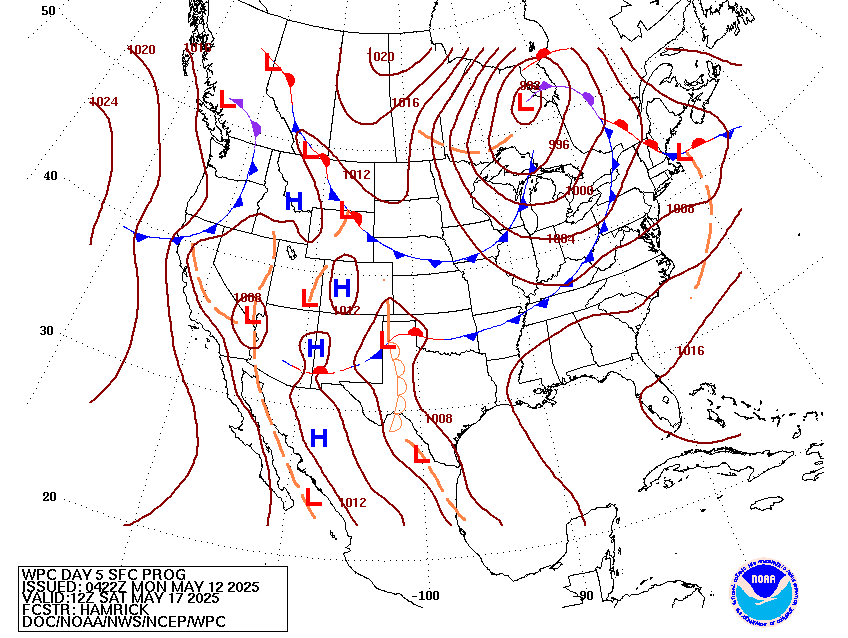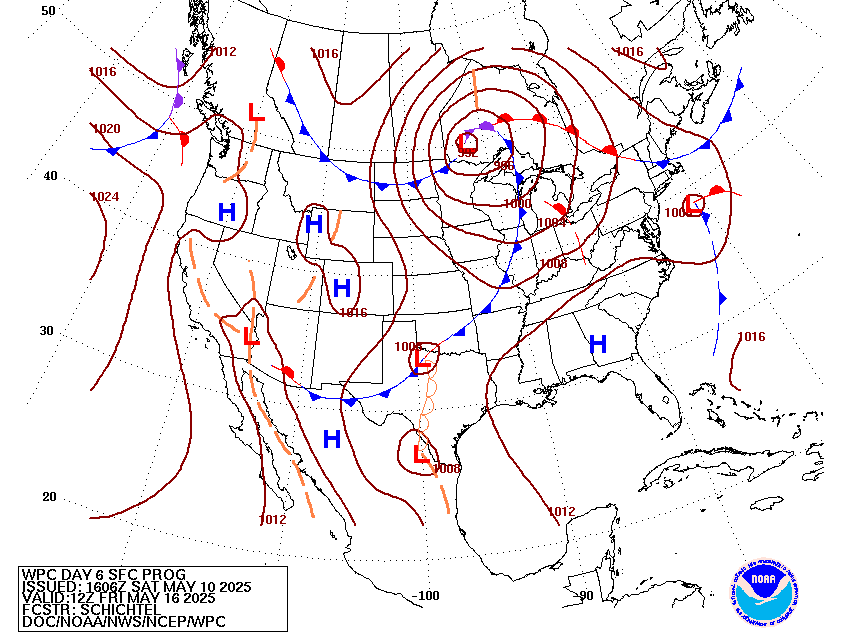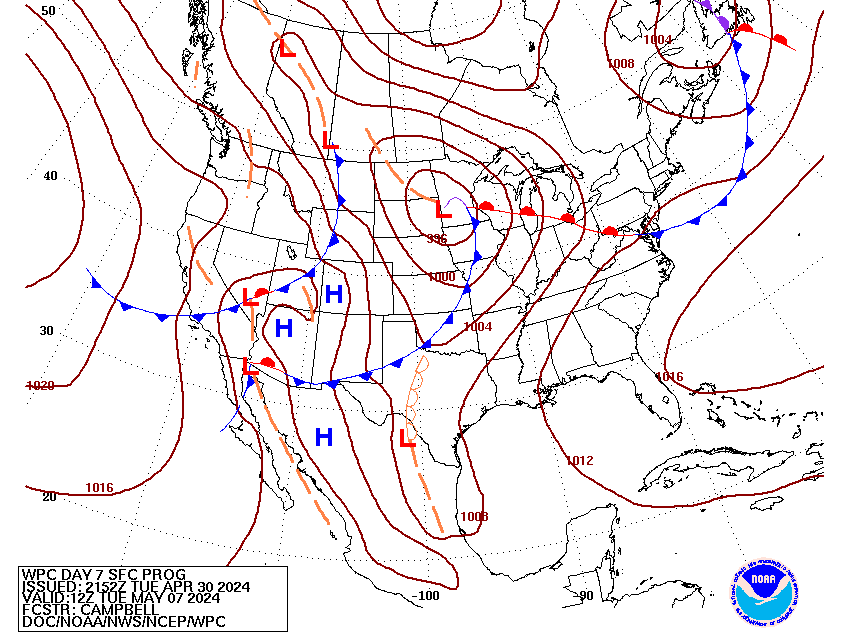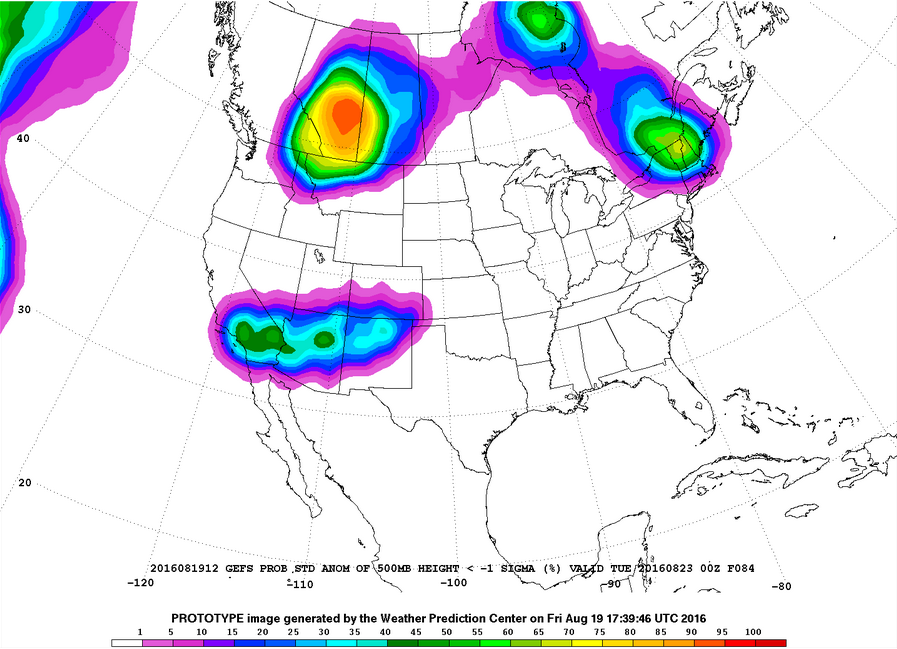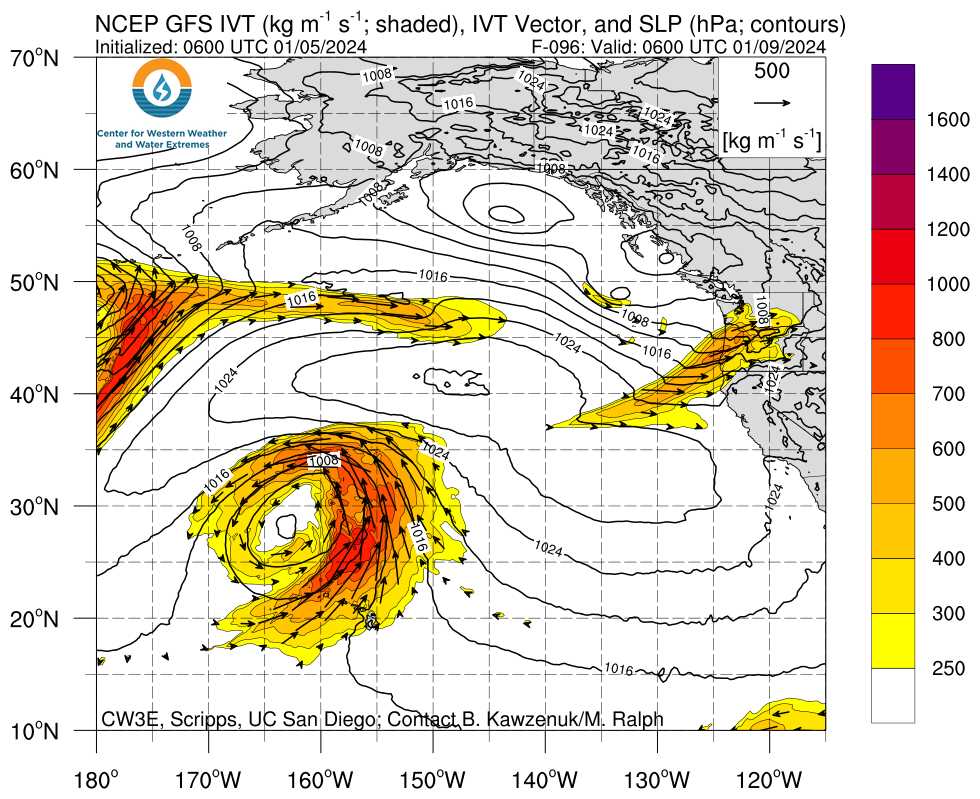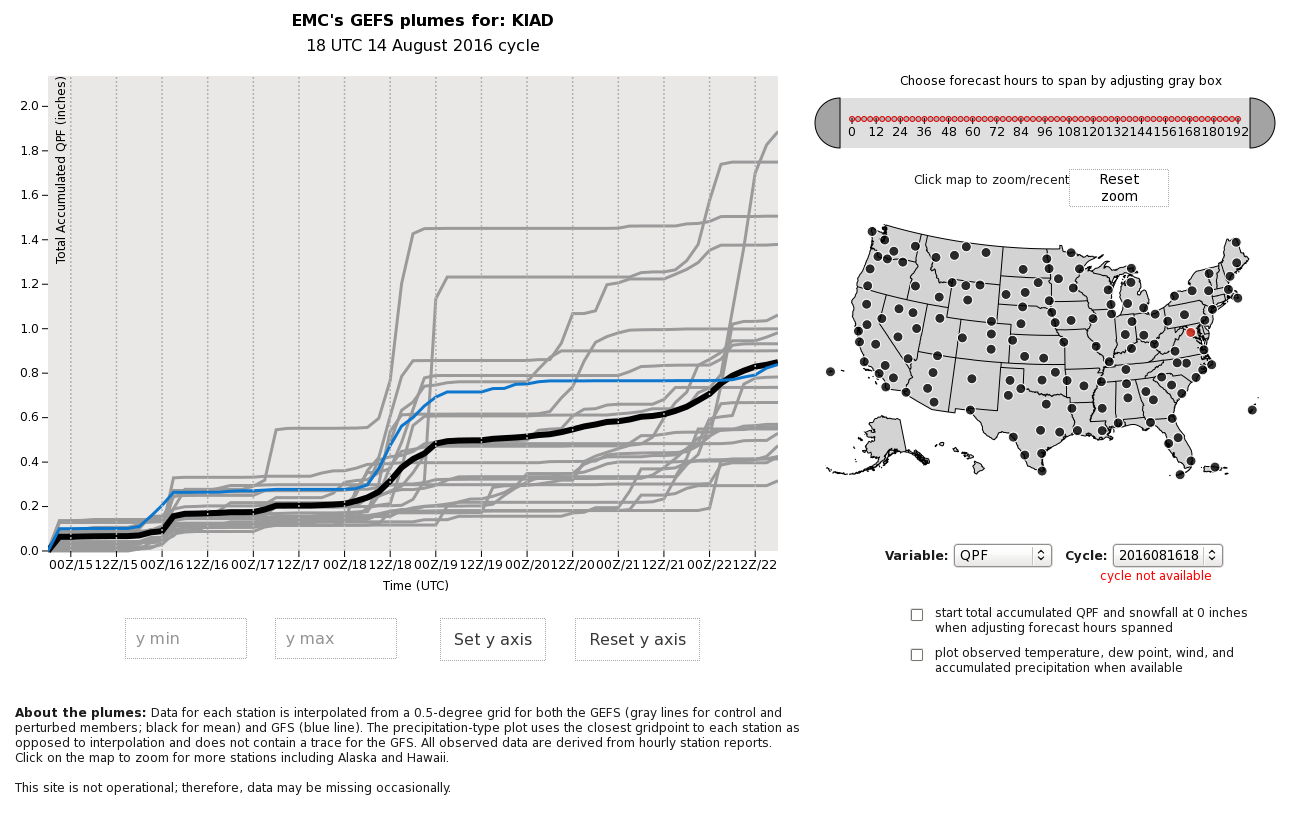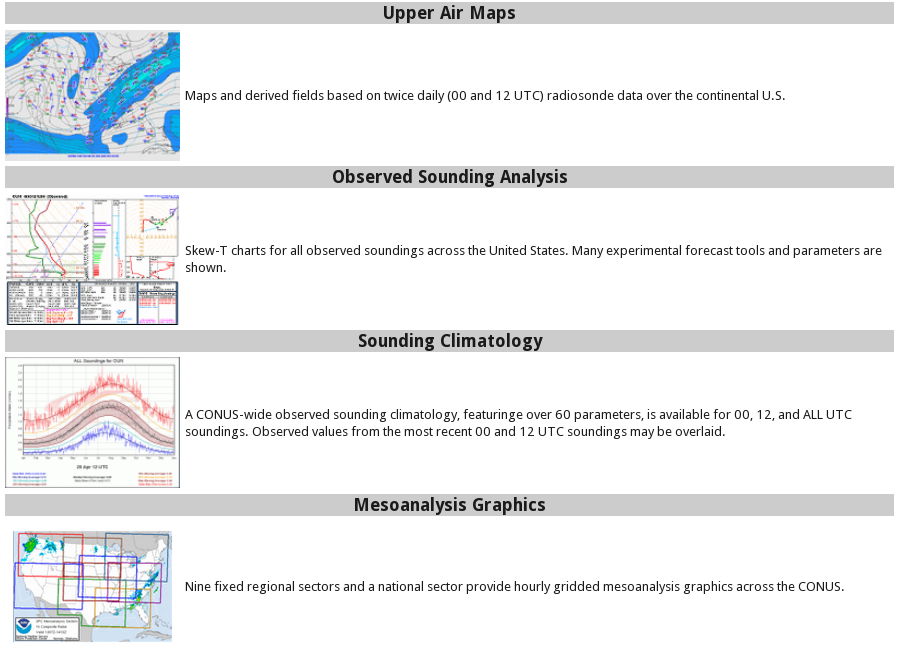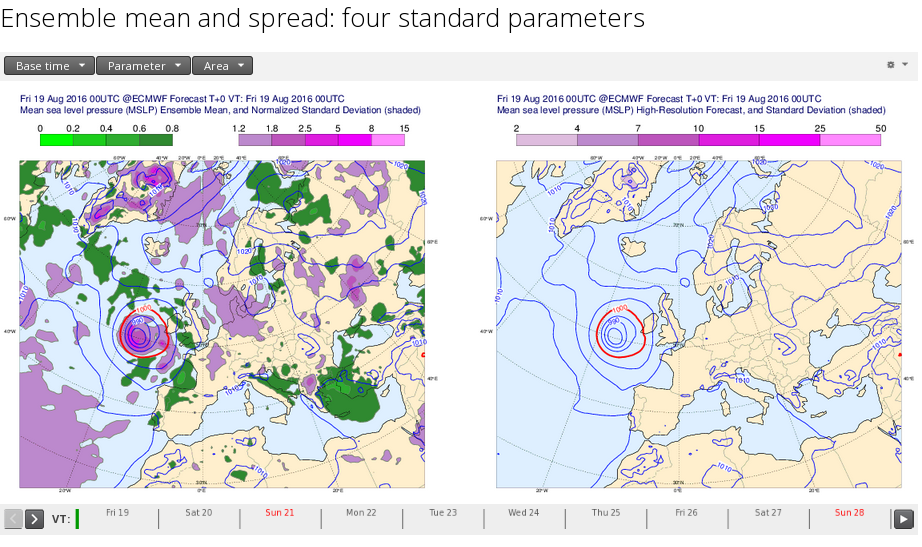Excessive Rainfall Discussion
NWS Weather Prediction Center College Park MD
411 PM EDT Sun Jul 13 2025
Day 1
Valid 16Z Sun Jul 13 2025 - 12Z Mon Jul 14 2025
...THERE IS A MODERATE RISK OF EXCESSIVE RAINFALL FOR PORTIONS OF
THE TEXAS HILL COUNTRY...
20Z Update...
Risk areas shifted south from the Concho Valley per latest guidance
and observations.
16Z Update...
...Southern Plains into Eastern Arkansas...
The ongoing convective complex over Central Texas continues to
show weakening trends overall from a very active overnight/morning.
A large MCV is noted between San Angelo and Killeen which should
continue to allow some development/expansion southeast toward San
Antonio and on the west side north of Del Rio through the early
afternoon. However, the reduction of the LLJ through this morning
should maintain lower rain rates than were experienced this
morning.
The question is what happens tonight with convection. 12Z CAMs are
overall not very concerning, but the RAP presence of 2.25" PW
pooling south of the current MCV which becomes the inflow for the
LLJ tonight means anything that does develop in central TX should
have healthy inflow for additional heavy rains. Therefore, will
maintain a Moderate Risk, but with a bit more of an east-west
orientation and a little south than current. This is mainly along
the SJT/EWX boundary including a fair portion of the Texas Hill
Country including Kerr Co.
Farther northeast/downstream of the existing MCV and east of a
stationary front, elevated moisture and instability will continue
to allow some organization over northeast TX, eastern OK, western
AR where a Slight Risk remains in effect.
...New Mexico...
The westward periphery of the PW plume emerging from the Gulf is
spreading into New Mexico, spreading PWs above 1" (+1 sigma) into
the High Plains and into the terrain of the central part of the
state. This PW will overlap with a ribbon of MUCAPE around 2000
J/kg to support scattered to numerous thunderstorms developing
during peak heating over the higher terrain. These storms will
initially move slowly on 0-6km mean winds of just 5 kts, but the
presence of 20-25 kts of bulk shear will help drive modest
organization as storms come off the terrain and drift southward on
Corfidi vectors around 10 kts. With rain rates above 1"/hr likely,
this could result in instances of flash flooding, especially over
sensitive terrain features, urban areas, or burn scars. A Slight
Risk is maintained over the Sacramento into north-central NM
terrain. The Marginal Risk is expanded to southeast AZ, more of
south-central CO, and more of eastern NM.
...Missouri and Illinois...
Minor expansion of the Slight Risk over northeast MO and south-
central IL. Ongoing activity is present along a stationary front.
MPD 0669 is forthcoming with further information.
...Mid-Atlantic into the Northeast...
16Z Update...Minor expansion east with Slight Risk over/toward the
I-95 corridor per 12Z CAM consensus.
Mid-level ridge gradually pulsing northward from the Gulf Coast
will interact with a broad and slow moving trough advecting across
the Great Lakes to produce pinched SWly flow across much of the
eastern CONUS. This will manifest as impressive thermodynamics
being drawn northward from the Mid-Atlantic into interior portions
of the Northeast. These thermodynamics will be characterized by PWs
of 1.75 to 2.0 inches (90th - 99th percentile according to NAEFS)
and collocated MUCAPE of 1000-2000 J/kg to produce an environment
favorable for heavy rain. Into this environment, a cold front,
pushed slowly eastward by the mid-level trough to the west, will
combine with slow height falls to drive pronounced ascent, creating
scattered to numerous thunderstorms from the eastern Ohio Valley
into Northern New England.
These storms will contain heavy rain rates that have a 30-50% chance
of exceeding 1"/hr with brief 2+"/hr rates also possible. Although
bulk shear is progged to be minimal such that convection will
generally remain of the pulse variety, brief training as 0-6 km mean
winds aligns to the front will allow for some longer duration of
this heavy rainfall in a few areas, leading to HREF and REFS 24-hr
probabilities that peak above 70% for 3". While it is difficult even
at this time range to identify the areas most at-risk to flash
flooding due to uncertainty in exact convective placement, 0-10cm
soil moisture is above the 90th percentile according to NASA SPoRT
from central VA through Upstate NY, which is also collocated with
the locally higher ensemble probabilities. This suggests that the
inherited SLGT risk is warranted, and only adjusted cosmetically
for new guidance, although there is a signal in the guidance for
some locally heavier rainfall across the Finger Lakes region of NY
due to repeating/backbuilding cells which could result in some
locally more substantial impacts.
...Florida...
16Z Update...
Expansion west of Marginal Risk per 12Z CAM consensus.
Slow moving 500mb trough east of Florida will strengthen gradually
as it drifts W/SW today. The accompanying vorticity maxima will
provide some locally enhanced forcing to the eastern side of FL,
while the entire peninsula remains sandwiched between this and a
ridge to the west, producing northerly flow across the area. As the
vort swings westward, some locally enhanced diffluence will
develop aloft as well, and as this occurs in the presence of PWs
above 2 inches collocated with MUCAPE of 2000-3000 J/kg, widespread
convection with heavy rain will result. CAMs suggest storms will
fire on the E/NE side of the peninsula and then drift SW, with some
locally enhanced organization possible into clusters thanks to
20-30 kts of bulk shear. With rain rates progged by the HREF to
have a 30-50% chance of exceeding 2"/hr, this could result in total
rainfall of 3-4", locally higher, as suggested by 24- HREF/REFS
probabilities and PMM. Where this rain occurs over more urban
areas, local flash flooding could result.
...Louisiana...
Added a Marginal Risk for central LA as outer bands from a tropical
wave over the central Gulf continues to produce development in a
moist/unstable environment. This includes Baton Rouge and
Lafayette.
Jackson
Day 1 threat area:
www.wpc.ncep.noaa.gov/qpf/94epoints.txt
Excessive Rainfall Discussion
NWS Weather Prediction Center College Park MD
411 PM EDT Sun Jul 13 2025
Day 2
Valid 12Z Mon Jul 14 2025 - 12Z Tue Jul 15 2025
..THERE IS A SLIGHT RISK OF EXCESSIVE RAINFALL FOR MUCH OF THE
MID-ATLANTIC AND NORTHEAST AS WELL AS THE FLORIDA PENINSULA...
...Mid-Atlantic Through Northeast...
There is an overnight threat of thunderstorms tracking across
southern portions of the Midwest that could still be going over
eastern KY/southern OH early Monday. The Marginal Risk was expanded
east through this area to account for this threat.
Then, diurnally driven thunderstorms develop ahead of a slow
moving cold front over the northern/central Appalachians and track
east to the I-95 Northeast urban corridor through the evening. The
front is slow to advance because the parent upper low remains
stationary into midweek. Broad return flow ahead of the front (SW
at 10-15 kts) draws a ribbon of PWs around 2 inches (above the 90th
percentile according to NAEFS), sufficient instability (MUCAPE
over 1000 J/kg into New England), deep warm cloud depths (above
15,000 ft) and light mean layer flow to support efficient and heavy
rain. Rain rates exceeding 2"/hr have a 40-60% probability from
the 12Z HREF, especially in the Mid-Atlantic.
Guidance today increased the likelihood of heavy rain up through
New England, so the Slight Risk was expanded through New Hampshire
in coordination with WFOs GYX, ALY, BGM, and PHI.
...Florida...
A westward-advancing and deepening mid-level wave approaches the FL
peninsula on Monday, providing widespread increasing ascent. In
addition to the height falls/PVA accompanying this trough, modest
upper diffluence will develop as northerly flow continues,
enhancing deep layer lift. This impressive and amplifying ascent
will impinge into intensifying thermodynamics with PWs surging
above 2.25 inches, or above the 90th percentile according to NAEFS.
There continues to be some evolutionary discrepancies among the
various models, but in general the setup will be favorable for
widespread thunderstorms with heavy rainfall, especially during
peak heating when MUCAPE climbs above 2000 J/kg. The heaviest
rainfall now looks to develop across central and southern portions
of the peninsula. With rainfall rates likely eclipsing 2"/hr, some
bulk shear 20-30 kts to help organized convection into clusters,
and chaotic/weak storm motions, total rainfall could exceed 3" in
places. The inherited SLGT risk was focused just a little.
...Desert Southwest through Texas, the Ozarks and Mid-Mississippi
Valley...
MCVs and impulses will track along the existing stationary front
over the Mid-Miss Valley down to Texas. A very favorable
environment remains to support heavy rainfall with PW nearly 2
inches into the Ozarks and above 1" as far as southern Arizona
thanks to persistent moist advection out of the Gulf leading to PW
anomalies reaching above the 90th percentile locally from West TX
into NM and near the Ozarks. These are the locations that may have
slightly higher potential for excessive rainfall on Monday, with
slow moving storms over West Texas/New Mexico (0-6km mean winds 5
kts or less) and organized convection on 20-30 kts of bulk shear
from OK into MO/AR. As of now the Marginal was expanded more over
southern Texas given the threat for further overnight activity
from central TX.
...Northern Plains...
Marginal Risk along Canadian border from MT to MN retained. Potent
but positively tilted shortwave will dig out of British Columbia
and emerge into a belt of pinched westerlies aligned to the
Canada/United States border. This will help elongate a cold front
as it drops southward into the Northern Rockies and Northern High
Plains, producing locally enhanced ascent across the area. A piece
of this vorticity lobe will swing rapidly eastward and interact
with the low-level baroclinic zone, which will intensify due to
warm advection on an 850mb LLJ surging to 30 kts Monday evening up
the Plains, drawing thermodynamics characterized by PWs of 1-1.25
inches and MUCAPE of 1000 J/kg northward. This will support
scattered thunderstorms Monday night, and although cells should
remain progressive on 0-6km mean winds of 20-25 kts, aligned
Corfidi vectors to the mean wind and the front suggests training
which could produce 1-2" of rainfall and local FFG exceedance.
Jackson/Weiss
Day 2 threat area:
www.wpc.ncep.noaa.gov/qpf/98epoints.txt
Excessive Rainfall Discussion
NWS Weather Prediction Center College Park MD
411 PM EDT Sun Jul 13 2025
Day 3
Valid 12Z Tue Jul 15 2025 - 12Z Wed Jul 16 2025
..THERE IS A SLIGHT RISK OF EXCESSIVE RAINFALL FOR THE
SOUTHERN FLORIDA PENINSULA AS WELL AS THE UPPER MIDWEST TO CENTRAL
GREAT PLAINS...
...Florida...
The mid-level wave reaches the Florida Peninsula on Tuesday
providing ascent with PWs of 2-2.25 inches collocated with tall
skinny cape with MUCAPE above 1000 J/kg. There could also be a
surface low (please see NHC guidance) which would additionally
enhance ascent. As winds behind the wave turn back to the S/SE
across the peninsula, it will likely result in weakly convergent
boundaries upon which thunderstorms will blossom and track NW with
2+"/hr rates. Where these cells exhibit even short- term training,
especially atop urban areas or across soils moistened from rainfall
between now and then, instances of flash flooding could result
from 2-3" of rain with locally higher amounts. The Slight Risk for
the southern half of the Peninsula remains.
...Northern Rockies through the Upper Midwest...
A defined shortwave trough shifts east across MT Tuesday. This
will push a cold front, initially aligned generally west-to- east,
to become more SW to NE as it approaches the Upper Midwest the
latter half of the period. The accompanying ascent (driven by low-
level convergence, PVA, and jet- level diffluence) will produce
widespread convection on Tuesday areas with PWs above the 90th
percentile according to NAEFS. This will support rainfall rates of
1-2"/hr, with training of echoes likely due to boundary parallel
mean flow.
The greatest potential for heavy rainfall continues to be focused
from the eastern Dakotas through northern MN with additional maxes
south/southwest across eastern SD to central Nebraska where
backbuilding/regenerating cells appear likely. The Slight Risk was
expanded over central MN to align with 12Z consensus (that includes
the 12Z RRFS and Canadian Regional).
...Northeast, Mid-Atlantic and Southeast...
A generally moist and unstable environment will remain across much
of the eastern CONUS Tuesday morning as broad ridging expands from
the Atlantic. A lingering surface front over southern New England
retains an excessive rainfall threat from overnight convection. So
a Marginal risk was raised up through Boston.
850mb flow around the offshore ridge will become increasingly
S/SE, surging a ribbon of PWs above 2" from the Gulf Coast through
the Mid-Atlantic. Although forcing for ascent will be modest,
widespread showers and thunderstorms are expected, many of which
will have 1-2"/hr rain rates despite their pulse nature. Therefore,
the Marginal Risk was maintained for the Mid-Atlantic down to
Georgia.
...Mid-Mississippi Valley...
Continued risk for MCV coming out from central TX activity looks to
push through MO/IL on Tuesday. Elevated moisture and pivoting
forcing from associated impulses raise a threat for excessive rain.
A Marginal Risk is raised for much of IL, eastern MO into central
IN.
...Southwest...
Elevated moisture with light steering flow should allow diurnal
convection to be locally excessive over the Big Bend of Texas and
southeast Arizona. Targeted Marginal Risks were raised for both
areas.
Jackson/Weiss
Day 3 threat area:
www.wpc.ncep.noaa.gov/qpf/99epoints.txt
Extended Forecast Discussion
NWS Weather Prediction Center College Park MD
254 PM EDT Sun Jul 13 2025
A surface low pressure system (which the National Hurricane Center
is now monitoring with low probabilities of tropical cyclone
development) will be retrograding into the Gulf by midweek after
crossing Florida, and potentially reaching the central Gulf Coast
Thursday-Friday. Moisture above the 90th percentile looks to remain
over western Florida and reach the central Gulf Coast by the
medium range, after a wet early part of the week in Florida. A
Marginal Risk is included on both the Day 4/Wednesday and Day
5/Thursday Excessive Rainfall Outlook (ERO) for those areas. Heavy
rain may linger in the Gulf Coast region into next weekend.
Much of the nation from the Rockies eastward will be active with
typical summertime convection in a warm and unstable airmass. A
cold front stretching from the Upper Midwest southwest into the
central Plains on Wednesday will support support showers and
thunderstorms with ample moisture and instability, resulting in a
heavy to excessive rainfall threat. Wednesday's ERO shows a
Marginal Risk from the Midwest extending back into central Plains
near and ahead of the front, while also covering farther south and
east into the Appalachians where orographics could play a role in
forcing thunderstorms. Additionally, there may be convection with
moderate to heavy rain rates in the northern High Plains lingering
Wednesday morning after a wet Tuesday night, so a Marginal Risk is
in place there as well. By Thursday and the Day 5 ERO, the gradual
shift of the front toward the Northeast and south through the Ohio
Valley allows the Marginal Risk to shift more into the Ohio
Valley/Mid-Atlantic and Northeast. On both days, included the
central Rockies/Plains into the Marginal considering the front
stalling and possible west-east training of convection. Even by the
start of the period Wednesday there is considerable spread with
the model guidance regarding heavy rain amounts and placement, so
the Marginals are quite broad in order to cover the widespread
threat. Generally this is a low-end and isolated flash flooding
threat equating to a Marginal Risk, but some areas may eventually
need embedded Slight Risks in future cycles if models converge. The
East could continue to see scattered thunderstorms into late week,
while the front lifting north could lead to additional convection
in the north-central Plains and Midwest as well.
Farther south, monsoonal moisture will gradually increase in
coverage across the Southwest/Four Corners/southern Rockies region.
Marginal Risks are in place across much of Arizona and New Mexico
and stretching into Colorado for both Wednesday and Thursday. Areas
like burn scars and urban areas would be of greatest concern for
flash flooding. The monsoon pattern should continue into next
weekend.
Hot weather may linger in the Pacific Northwest through around
midweek, but temperatures in the northern High Plains will cool
dramatically by Wednesday with highs around 15 to 25 degrees below
normal. Temperatures there should slowly warm closer to average
late week. Temperatures look to be a few degrees cooler than
average for the south-central U.S. for much of the week as clouds
and rain hold temperatures down. The Great Lakes and Northeast will
see warmer than average temperatures Wednesday and Thursday under
an upper ridge, with somewhat widespread Major (level 3/4) HeatRisk
showing up in those areas and points southward mid-late week. In
the Northeast, a cold front will allow temperatures to cool toward
normal by next wekeend. Meanwhile the Southeast should be near
normal most days, for typical summer heat and humidity.
Tate/Santorelli
Extended Forecast Discussion
NWS Weather Prediction Center College Park MD
254 PM EDT Sun Jul 13 2025
A surface low pressure system (which the National Hurricane Center
is now monitoring with low probabilities of tropical cyclone
development) will be retrograding into the Gulf by midweek after
crossing Florida, and potentially reaching the central Gulf Coast
Thursday-Friday. Moisture above the 90th percentile looks to remain
over western Florida and reach the central Gulf Coast by the
medium range, after a wet early part of the week in Florida. A
Marginal Risk is included on both the Day 4/Wednesday and Day
5/Thursday Excessive Rainfall Outlook (ERO) for those areas. Heavy
rain may linger in the Gulf Coast region into next weekend.
Much of the nation from the Rockies eastward will be active with
typical summertime convection in a warm and unstable airmass. A
cold front stretching from the Upper Midwest southwest into the
central Plains on Wednesday will support support showers and
thunderstorms with ample moisture and instability, resulting in a
heavy to excessive rainfall threat. Wednesday's ERO shows a
Marginal Risk from the Midwest extending back into central Plains
near and ahead of the front, while also covering farther south and
east into the Appalachians where orographics could play a role in
forcing thunderstorms. Additionally, there may be convection with
moderate to heavy rain rates in the northern High Plains lingering
Wednesday morning after a wet Tuesday night, so a Marginal Risk is
in place there as well. By Thursday and the Day 5 ERO, the gradual
shift of the front toward the Northeast and south through the Ohio
Valley allows the Marginal Risk to shift more into the Ohio
Valley/Mid-Atlantic and Northeast. On both days, included the
central Rockies/Plains into the Marginal considering the front
stalling and possible west-east training of convection. Even by the
start of the period Wednesday there is considerable spread with
the model guidance regarding heavy rain amounts and placement, so
the Marginals are quite broad in order to cover the widespread
threat. Generally this is a low-end and isolated flash flooding
threat equating to a Marginal Risk, but some areas may eventually
need embedded Slight Risks in future cycles if models converge. The
East could continue to see scattered thunderstorms into late week,
while the front lifting north could lead to additional convection
in the north-central Plains and Midwest as well.
Farther south, monsoonal moisture will gradually increase in
coverage across the Southwest/Four Corners/southern Rockies region.
Marginal Risks are in place across much of Arizona and New Mexico
and stretching into Colorado for both Wednesday and Thursday. Areas
like burn scars and urban areas would be of greatest concern for
flash flooding. The monsoon pattern should continue into next
weekend.
Hot weather may linger in the Pacific Northwest through around
midweek, but temperatures in the northern High Plains will cool
dramatically by Wednesday with highs around 15 to 25 degrees below
normal. Temperatures there should slowly warm closer to average
late week. Temperatures look to be a few degrees cooler than
average for the south-central U.S. for much of the week as clouds
and rain hold temperatures down. The Great Lakes and Northeast will
see warmer than average temperatures Wednesday and Thursday under
an upper ridge, with somewhat widespread Major (level 3/4) HeatRisk
showing up in those areas and points southward mid-late week. In
the Northeast, a cold front will allow temperatures to cool toward
normal by next wekeend. Meanwhile the Southeast should be near
normal most days, for typical summer heat and humidity.
Tate/Santorelli
